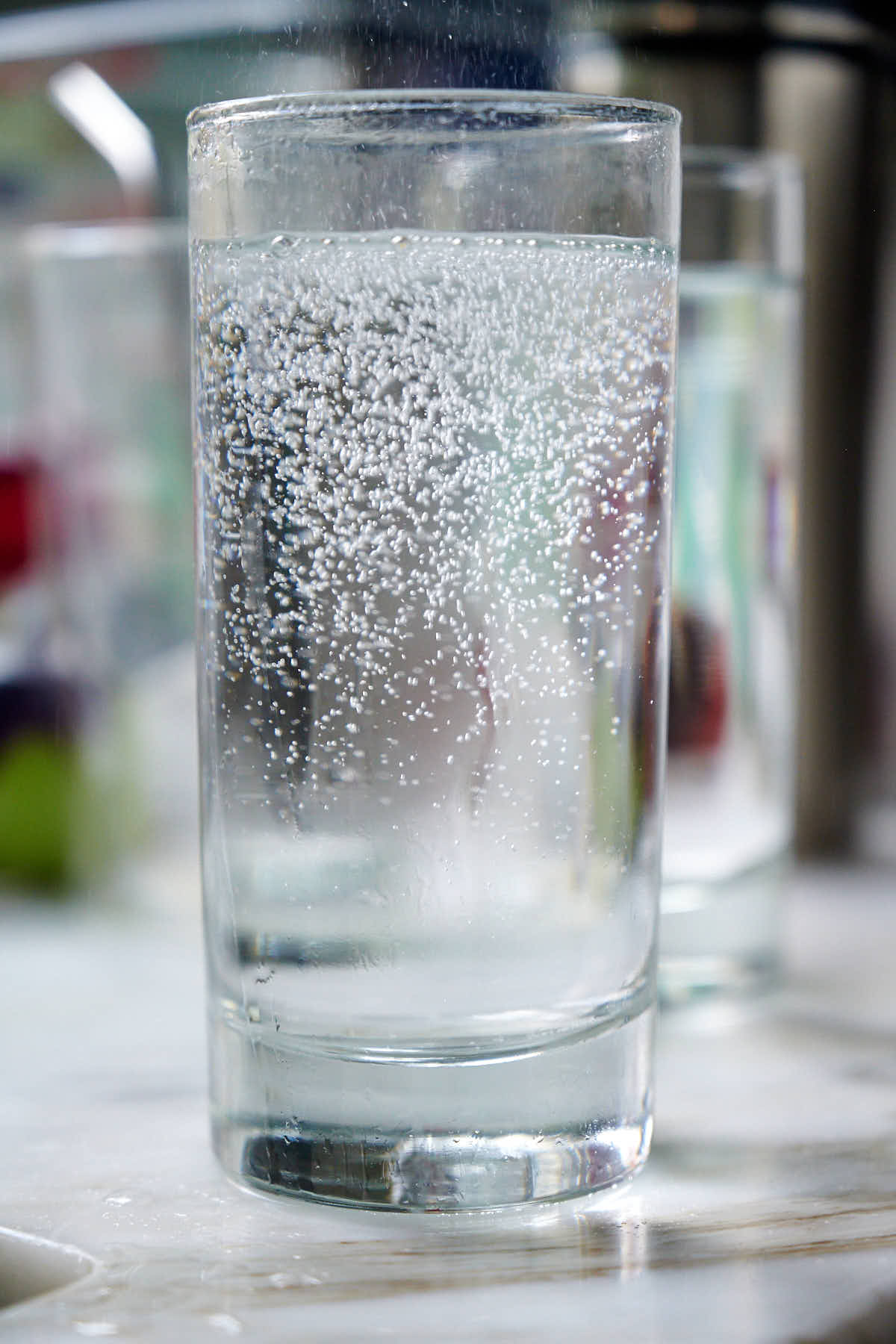
If you like carbonated water you probably have noticed how expensive it has become over the past 5-7 years. I used to be able to buy a 25 oz bottle of Perrier for a dollar at the local grocery store, now it's $1.79. If you like to drink a lot of fizzy liquid it can quickly add up to a nice chunk of change. The good news is that you can make your own carbonated water, and it will only cost you pennies per gallon.
I am a big fan of carbonated water, and so is everyone in my family. I think I had a lot to do with that. We tend to drink a lot more water when it's carbonated, and drinking plenty of water is good for your body. The problem is that carbonated water isn't getting any cheaper. It's quite the opposite, and it can get pretty darn expensive if you drink a lot. That, plus lugging all those bottles from the store, recycling empties, and constantly making sure you don't run out of the fizzy liquid forced me to look into how to make carbonated water at home. Specifically, I wanted to come up with a solution that would to be:
1. Cost efficient
2. Convenient
3. Easy to use, even for small kids
Jumping a little bit ahead let me tell you that I currently own a DIY kegerator that I use for making sparkling water. I consider it the Rolls Royce of seltzer water makers. It's got everything I was looking for. It's an attention grabber too when folks come to visit. Some are disappointed that it dispenses water instead of beer. I am telling them to be patient as the real thing is coming.
I am using carbonated water and seltzer water or simply seltzer interchangeably as they mean the same thing - force carbonated water using CO2 gas. Some people have asked me if one can make club soda at home. The answer is both yes and no.
Seltzer water and club soda are very similar, but there is an important difference between the two. Club soda's flavor is enhanced by adding mineral-like ingredients such as potassium bicarbonate and potassium sulfate. If you have a way of adding those minerals in your water (for example by using a re-mineralizing water filter that adds those specific minerals), then yes, you can make your own club soda at home. Otherwise it will be plain old seltzer water. While I believe that club soda and seltzer can be easily substituted, some argue that the difference in taste is perceptible.
SodaStream
SodaStream Fountain Jet Home Soda Maker Starter Kit was the obvious first choice to look into and I liked what I saw - a compact package, ease of use and excellent reviews. It promised to be a very decent seltzer water maker and just what I was looking for. I liked what I saw, bought it and used it successfully until I upgraded to the next level water carbonation rig.
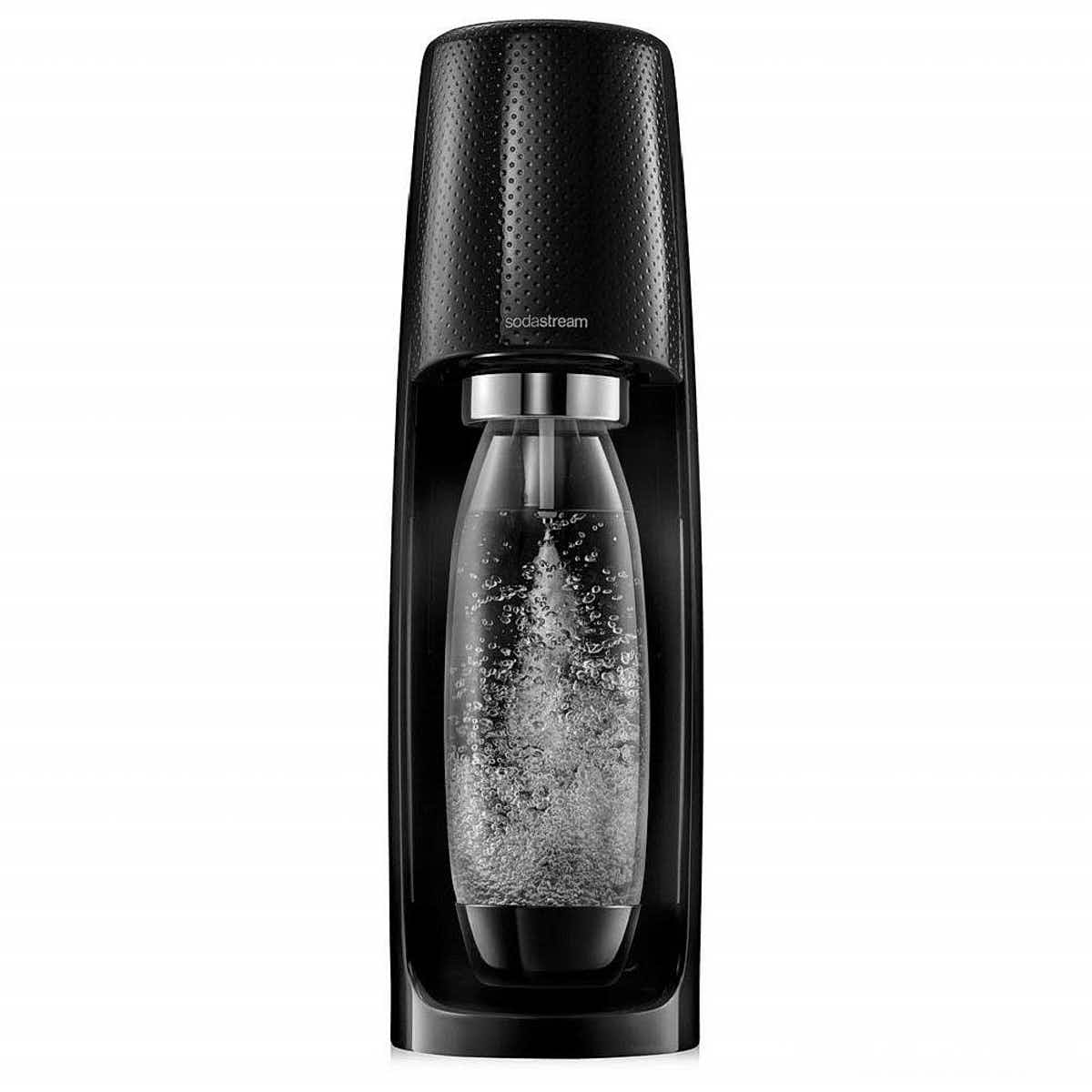
When using SodaStream $15 dollar refills, cost per liter varies from $0.25 to $0.4-$0.5 depending on the level of carbonation you want to achieve. With an adapter and a paintball C02 tank the cost will vary from $0.05 to $0.1 per liter depending on the level of carbonation and the number of loud buzzes you will go through during carbonation.
SodaStream pros:
- Fairly easy to use for adults
- Very portable
- Very compact
- Reasonably well built
- Good carbonation
- Relatively small initial investment of about $80 (for the entry level SodaStream) plus $20-60 for the adapter and $20-25 for the paintball CO2 tank
SodaStream cons:
- Not so easy to use for children, but you can help them and its fun to do this together
- Three loud buzzes as per the instructions are definitely not enough to achieve decent carbonation that is comparable to carbonation in store-bought carbonated water. I would do 5-6
- Adjusting level of carbonation involves guesswork and experimentation
- CO2 refills at $15 a pop are somewhat expensive, though in the end there are some savings to be realized. There is a real opportunity to lower the cost of carbonation with the mod described above
- Water needs to be pre-chilled for quicker and more effective carbonation
- Need to remember to place carbonated water into fridge to keep it chilled
Modded SodaStream system
Some cost conscious SodaStream users have turned to getting the popular SodaMod SodaStream CO2 adapter which allows utilizing standard paintball tanks with SodaStream. Reportedly, these standard paintball tanks can be refilled at numerous paintball shops and sports goods stores at a fraction of cost - about $3 a pop. The guys at SodaMod will even help you find a refill location if you are not able to locate one yourself, or so they claim.
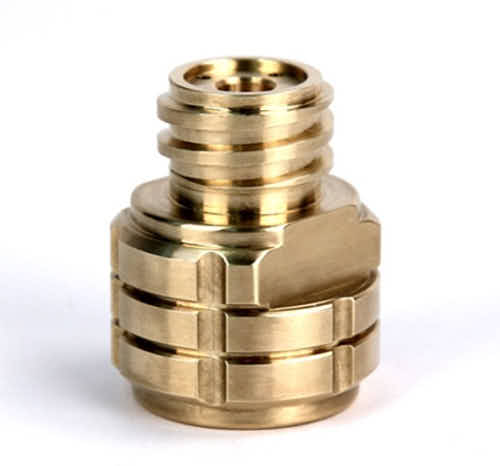
Alternatively, Amazon sells a similar CO2 Conversion Adapter for SodaStream Paintball Tank Canister for less than half the price of the SodaMod adapter. You will need to splurge for a paintball CO2 tank too if you go with an adapter.
A word of caution!
Pay close attention to the quality of the CO2 gas you are using to carbonate water. While cheap, paintball shop and sports goods store CO2 gas is most likely not food grade and contains other gases mixed in. Ask before refilling your tanks there. The best advise is to do refills at beverage supply places that cater to food services industry and use food grade CO2 gas.
The Carbonater
The next level up is the The Carbonater system. It requires a slightly larger initial investment of about $140-$150 and to be comfortable using and servicing a gas regulator, gas tubing, etc. No worries, I am not a plumber and I had no experience with these things before I upgraded to the carbonater rig. It turned out to be very easy to setup and maintain. The most important thing with this setup is to ensure that there are no gas leaks after you put everything together - you don't want to use your carbonater for a couple of days and then realize you've run out of gas. Youtube has excellent videos on how to test your system with soap water. It's very easy.
Essentially, this setup consists of a CO2 tank
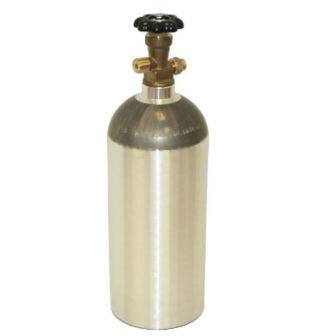
with a regulator to control CO2 gas pressure,
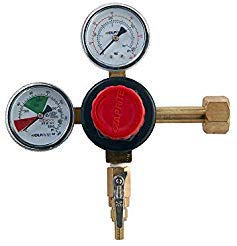
which is then connected via a gas line assembly
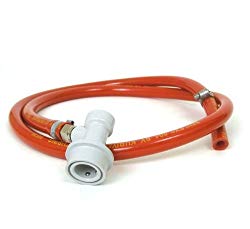
to the Carbonater cap.
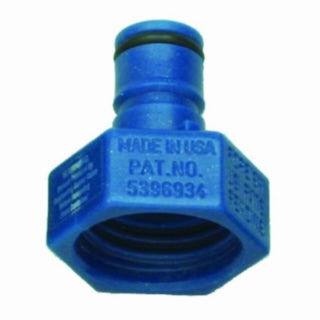
Update July 3, 2016
A reader emailed me that Amazon now carries stainless steel carbonation caps, which cost only a dollar more than that the plastic version above. Definitely go for the stainless version, it will last forever with basic care.
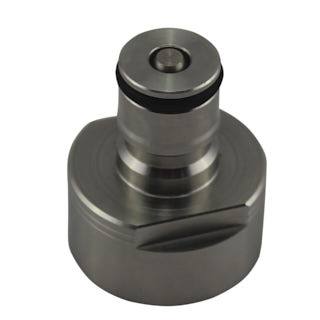
Carbonater pros:
- Fairly easy to use for adults
- The build is super solid and will last for years
- Makes excellently carbonated water, with carbonation levels to suite any taste
- You can adjust the level of carbonation on the gas regulator once and produce consistent results thereafter
- CO2 refills are cheaper than even for standard paintball tanks. Costs per liter are the same as when using the kegerator, see below
Carbonater cons:
- Les compact and less portable than the SodaStream
- Initial investment is slightly higher than that of the SodaStream solution
- Water needs to be pre-chilled for quicker and more effective carbonation
- Need to remember to place carbonated water into fridge to keep it chilled
- Not easy to use by younger children
The Kegerator
OK, everyone knows that a kegerator is for dispensing beer, but many have been using kegerators for carbonating water as well. This is the ultimate solution for water carbonation at home. I have been using it for the past 2 years and it's second to none.
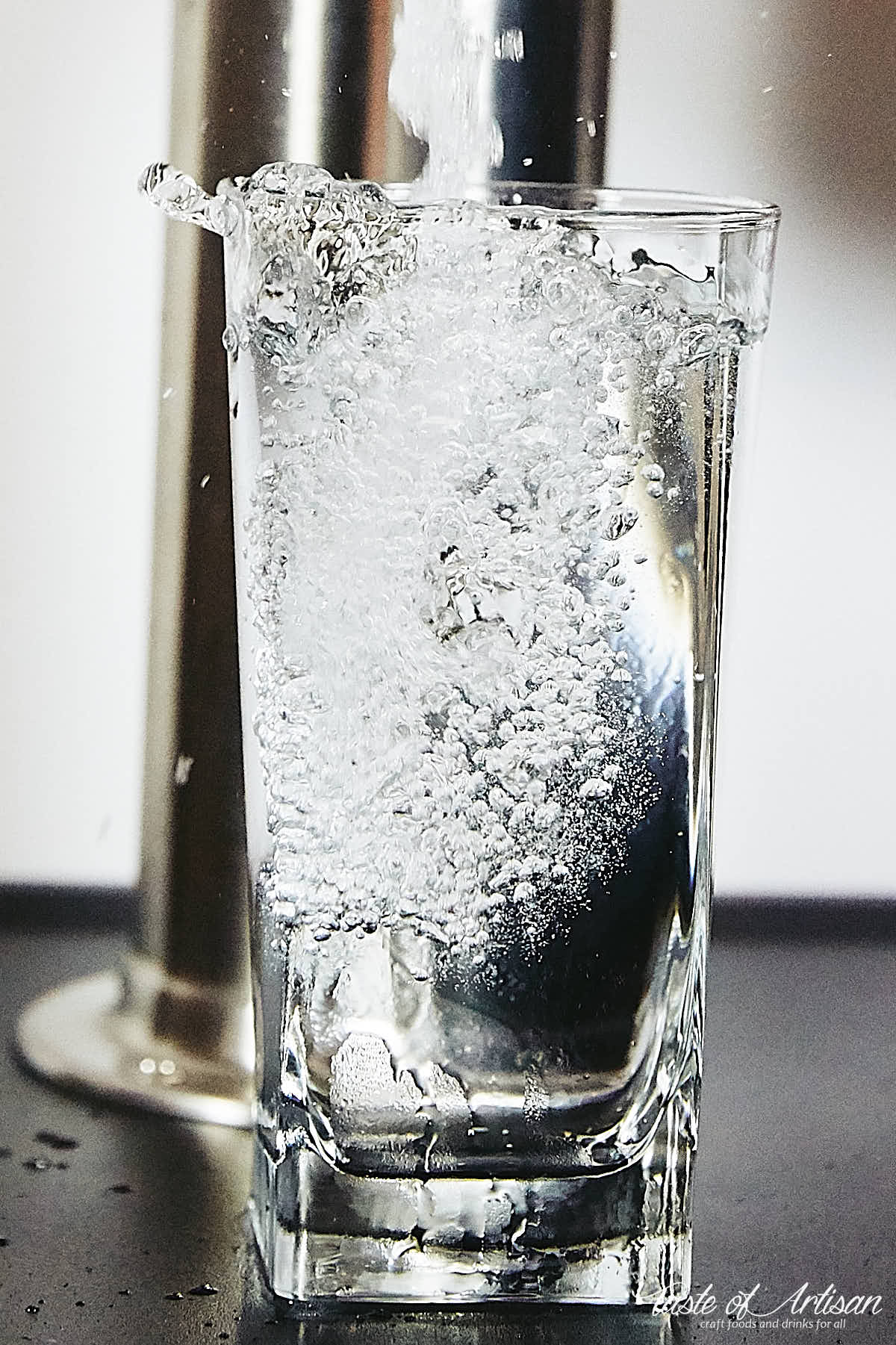
This solution advances the Carbonater solution by eliminating the Carbonater cap and adding a modified bar fridge (a minimum size of 4.4 cu.ft. Danby bar fridges have long been popular with kegerator DIY'ers), a 5 Gallon Soda/Beer Keg,
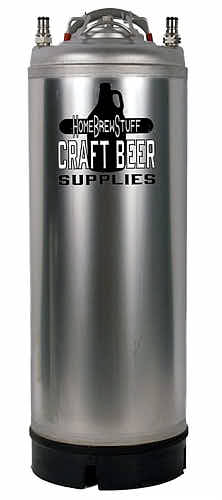
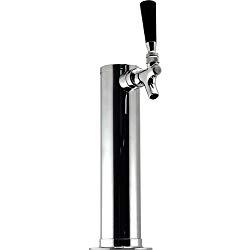
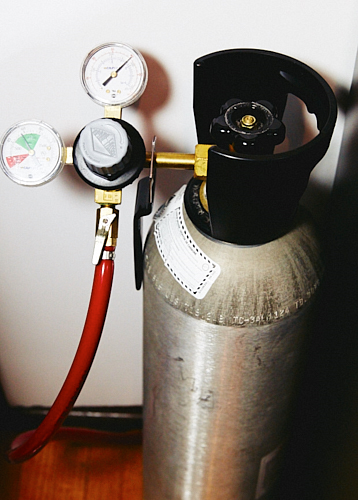
Our household goes through about 1 keg of water per week or so, and we would refill the CO2 tank about once a year or so. It's extremely convenient not having to do this every 3 weeks or even every couple of months. Keep in mind, though, that a 10, 15 or 20-lb CO2 tank will not fit inside a 4.4 cubic feet bar fridge with two 5 gallon kegs in it, and you will need to drill a hole and run the gas line outside.
If you want to keep your CO2 tank inside the fridge you must go with a 5 lb or 2.5 lb CO2 tank. Alternatively, you can go with a single 5 gallon keg and in which a case a 10 lb tank will fit in the fridge. The 15 lb CO2 tank will fit, i tried, but it will be tight and the regulator will need to be in horizontal position and it will be very tight. I think it's safer to keep a 15 lb tank outside and avoid risking damaging the regulator.
Over time I realized that a one-keg setup has a notable shortcoming - when water runs out you need to fill the keg with water immediately and wait until it carbonates. If you fill it up with room temperature water and let it carbonate at 40 PSI, it will take 24 hours to achieve low but noticeable carbonation, and full 48 hours to get optimum carbonation. Carbonation can be accelerated by using cold water and/or gently rolling the keg on the floor, but that's not convenient.
You could also potentially carbonate at 60 PSI (stainless steel cornelius soda kegs can withstand up to 130PSI max but I would not recommend going near that high) and then switch back to 25-40 PSI for dispensing, but that involves unnecessary hassle switching pressure back and forth. Because of that I started using 2 kegs in my system. Once water in one keg runs out, I already have a new keg ready for dispensing. The cycle goes as follows:
- Connect keg A filled with water to CO2 line and water line. Carbonate for 48 hours
- Add keg B filled with water. Move CO2 line from keg A to keg B and carbonate for 48 hours
- Move CO2 line back to keg A until it runs out of water (even though keg A is fully carbonated, the pressure will fall eventually the more water you use and you will need to connect CO2 line back for proper dispensing)
- Once keg A runs out of water, move water and CO2 lines to keg B for immediate consumption of carbonated water
- Refill keg A, add back to the fridge. Move CO2 line from keg B to keg A and carbonate for 48 hours
- And so on and so forth...
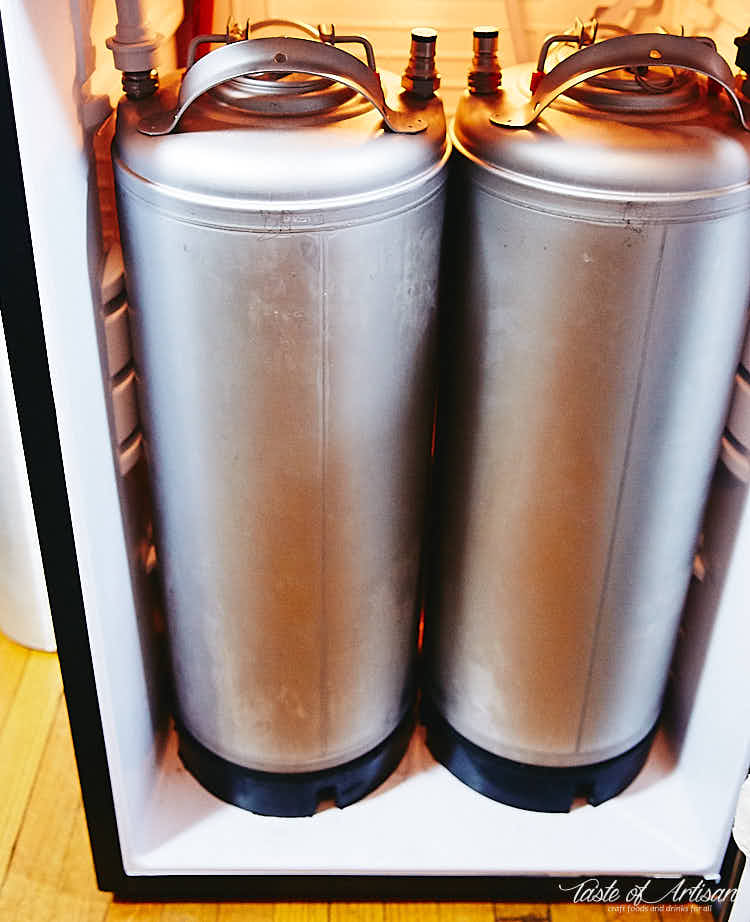
Update on July 3, 2016
You can easily see that the 2 keg carbonation process that I started off with was not particularly efficient. I later modified my system to be able to carbonate both kegs at the same time. That way I don't have to remember to switch disconnects back and forth between the kegs. Here is how I did it:
The easiest way, in my opinion, is to add a 2-Way CO2 Manifold. What it does is it allows you to feed CO2 gas from one output on C02 regulator to two kegs. That's what I did in my system. Going this route I did not have to drill another hole in my fridge and upgrade my CO2 regulator. Here is how it looks:
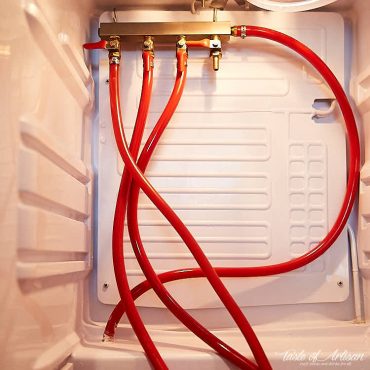
The CO2 line from the CO2 regulator feeds into the manifold. Then two CO2 lines run into each of the two kegs. Simple as that.
Note that I have a 4-way manifold in my system and have three CO2 lines connected to it. I happened to have a spare 4-way CO2 manifold laying around so I figured I'd use it. I then later added a third line with a 12-foot hose to use when cleaning my beer kegs. You may not need any of that, so a 2-way manifold will suffice.
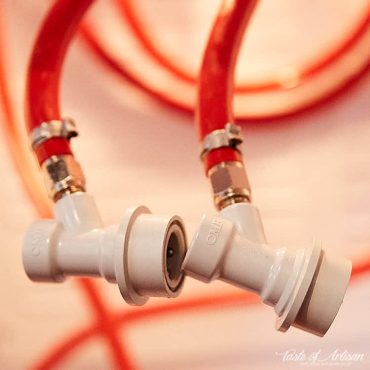
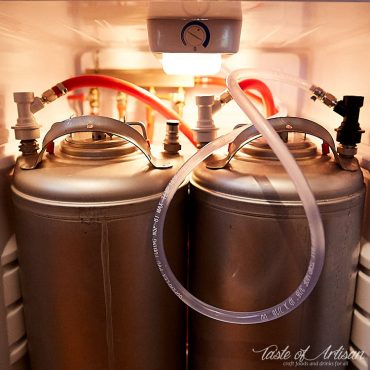
I keep the water hose in front of the kegs. That's not an accident. If you tuck it behind the kegs it will be touching the cooling plate in the back and the water in the hose will often freeze, especially after you add new water and the fridge starts to circulate more often to cool down the water.
Other ways to carbonate two kegs at the same time
Another way is to use a Dual Pressure CO2 Regulator. This will require drilling another hole in the fridge and running a second CO2 line. I think this option is an overkill. Going under the premise that you want the same level of carbonation in both of you kegs, there is absolutely no need to have a dual pressure CO2 regulator.
I happen to use one in another kegerator system of mine (picture below) but I do need different pressures there.
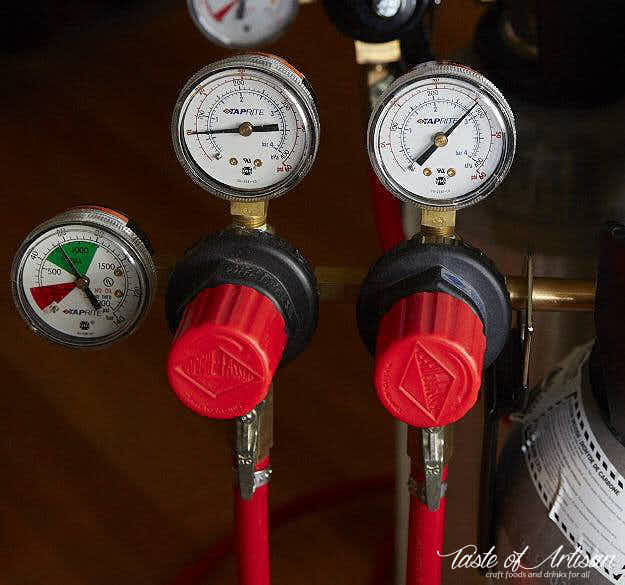
A more cost effective way would be to use a CO2 Regulator with WYE'd Dual Check Valves. You still will need to run two CO2 lines to your fridge and drill another hole. However, the cost of buying such a regulator or adding the the WYE'd dual connector to your existing CO2 regulator would still be quite a bit less than buying or upgrading to a dual pressure regulator.
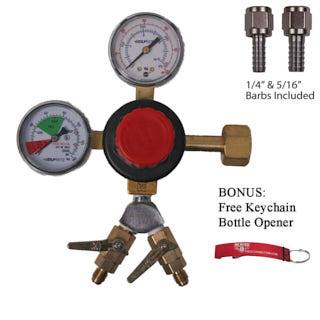
Given that a 15 lb cylinder refill costs me about $25 including taxes, that's about $0.41 per keg, $0.08 per gallon, or $0.02 per liter. Not bad, ha? It's freaking awesome! My wife says our kegerator setup was the most useful and the most prudent investment we have ever made. I agree. It's the best. The cost of water also needs to be considered, but in my case it's close to free as I use filtered (reverse osmosis, re-mineralized) tap water.
Kegerator pros:
- Carbonated water on tap - doesn't get any more convenient than that
- Very easy and simple to use for both adult and even younger kids - just pull the handle and pour
- The build is super solid and will last for years
- Makes excellently carbonated water, with carbonation levels to suite any taste
- You can adjust the level of carbonation on the gas regulator once and produce consistent results thereafter
- CO2 refills are cheaper than even for standard paintball tanks
- Assuming a 15-20 lb CO2 gas tank, gas refills are needed once a year or even longer
- Never run out of carbonated water assuming a two-keg system
- Water is always ice cold, no need to remember to keep the bottle with carbonated water in the fridge or to pre-chill water before carbonation
- Looks elegant and cool - everyone who comes over to visit wants to know how it works and wants to use it
Kegerator cons:
- High initial investment of about $450-$500 (this includes a new 4.4 cu.ft. or larger bar fridge). The cost can be reduced by about $100-$150 by buying used soda/beer keg and bar fridge.
- Not portable and requires more space
- Requires drilling one, potentially two holes in the carefully selected bar fridge (though there are numerous detailed guides online on how to turn an bar fridge into a kegerator)
- Fairly long carbonation time, but this is easily alleviated by a 2-keg setup

So, If you are just venturing into the world of water carbonation at home and are looking for an easy-to-use solution, SodaStream is for you. It makes very good homemade seltzer water with good carbonation. Savings with an un-modded setup are somewhat dubious, but with an adapter and a paintball CO2 tank the savings will be quite significant.
If you are looking to get into or upgrade to a more robust system that allows for consistent and precise control of level of carbonation without spending a lot of money, the Carbonator system is the best choice. This system is also a good entry level setup if you know you will eventually be upgrading to the Kegerator setup as all of the parts, save for the Carbonator cap, can be reused. Actually, the Carbonator cap can also have its place in the Kegerator system. The cost of carbonated water per liter with this setup is significantly lower than even with the modded SodaStream setup.
If you are looking for the ultimate setup that is also super easy to use even for younger kids, consider getting a Kegerator, like this EdgeStar Full-Size Kegerator.
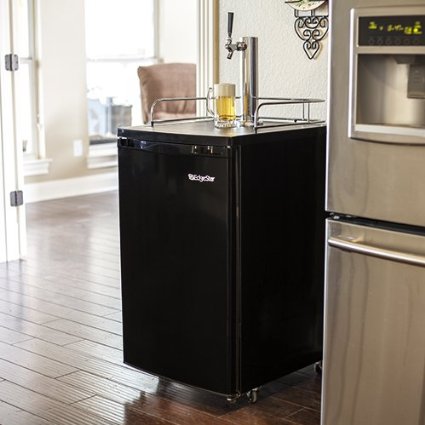
If you are up to building your own Kegerator, it can be a fun project and will save you a few bucks. A Kegerator looks very elegant and can be easily incorporated into any interior. The cost per liter of carbonated water is the same as that of the Carbonator setup.
Cheers and happy carbonation at home! Drop me a line if you have questions about any of these setups.
Update on October 20, 2016
I've been getting many emails and with questions specific to building a kegerator. Given this interest, I made a very detailed guide on How to Build a Kegerator. It basically describes everything you need to build a kegerator, down to what bolts and washers you will need. Hope this helps.
Update on March 19, 2019
I got a number of emails from people who procured kegerators or the carbonater systems and were looking for a hassle-free, inexpensive way to get good water. My recommendation is to use an RO water filter with re-mineralization. That's what I've been using over the past 2 years or so and have been very pleased with it.
Here are my recommended under-sink water filtration systems:
- Home Master Artesian Full Contact Reverse Osmosis Under Counter Water Filtration System (this is what I use)
- Five-stage iSpring RCC7 RO system from iSpring
- iSpring’s 6-stage iSpring RCC7AK RO system
- An RO system from APEC, APEC Water Systems ROES-PH75
Update on September 25, 2020
I replaced my RO system with the iSpring RCC7P-AK, which I like a lot except the re-mineralizing/alkaline filter. It made the water taste too minerally. I would describe the taste sour but the water wasn't acidic as the pH measured with my Hanna Instruments pH meter was 10.2. Too alkaline. Bad taste. When carbonated, it tasted even worse, to the point where I just couldn't drink it. I decided to keep the RO system and only replace the alkaline filter.
iSpring says their filter adds calcium, magnesium, sodium, and potassium. Home Depot says that this alkaline filer 'restores alkalinity by adding small amount (8 mg/L) of calcium and magnesium back into water.' I decided to use this opportunity and find a filter that adds even more minerals to get a 'natural spring water' taste, like Voss or Fiji.
After a lot of searching and testing, I found exactly what I need. It's a filter made by a Canadian company called Waterite. I purchased my filter from a place called thewaterguy.ca which distributes across Canada and the USA. I have no affiliation with them or Waterite, just happen to really like the filter.
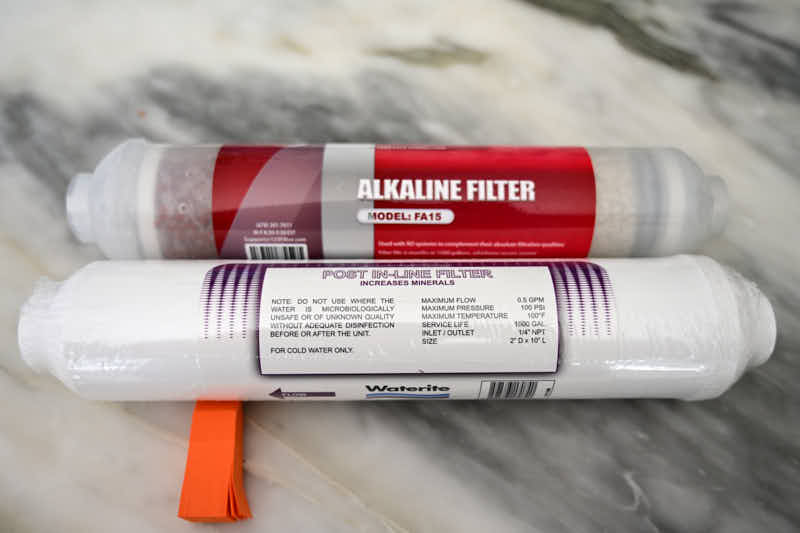
The water now tastes very, very good. The list of elements is comparable to natural spring water, like Fiji. The filter adds the following elements:
-
- SiO2 (Silicon Dioxide) 60-65%
- Al2O3 (Aluminum Oxide) 12-17.5%
- Fe2O3 (Ferric Oxide) 4.2-4.8% FeO (Ferrous Oxide) 0-1.3%
- CaO (Calcium Oxide) 3.8-6.1%
- MgO (Magnesium Oxide) 3.2-4.3%
- Na2O (Sodium Oxide) 4.1-4.4%
- K2O (Potassium Oxide) 0.2-1.3%
- MnO (Manganese(II) Oxide) 0.07-0.08%
- TiO (Titanium(II) Oxide) 0.21-0.49%
- P2O5 (Phosphorus Pentoxide) 0.06-0.18%
Update on September 28, 2020
We've been using the new Waterite alkaline filter with our RO system for the past 4 weeks and the taste that our water has acquired has been like never before. I decided to do a blind test to compare our RO water, plain and carbonated, against some of the popular and less popular brands. In many years of my carbonating water at home, this was the first time that I was quite confident that it would compare very well.
Here are the results:
Plain water (ranked from best to worst)
- Waterite, Evian/Waterite (tie), Waterite, Voss
- Fiji, Fiji, Voss, Waterite
- Aquafina, Aquafina, Aquafina, Glaceau Smartwater
- Glaceau Smartwater, Evian, Nestle, Aquafina
- Glaceau Smartwater, Nestle, Glaceau Smartwater, Fiji
- Nestle, Voss, Evian, Fiji
- Nestle, Voss, Evian
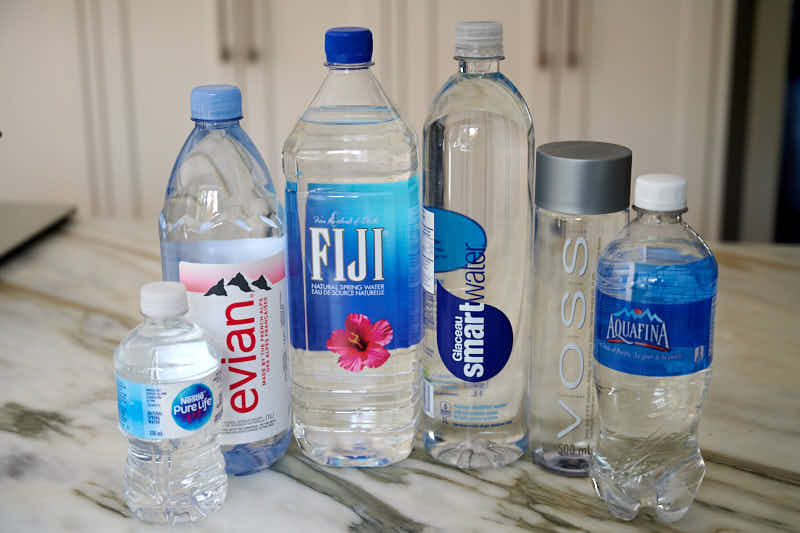
Carbonated water (ranked from best to worst)
- Waterite, Perrier/Waterite, Waterite, Waterite
- Perrier, Waterite, President's Choice, Voss
- President's Choice, Voss, Voss, Perrier
- Voss, San Pellegrino, San Pellegrino, President's Choice
- Perrier, Gerolsteiner, San Pellegrino, Gerolsteiner
- Gerolsteiner, San Pellegrino, Gerolsteiner
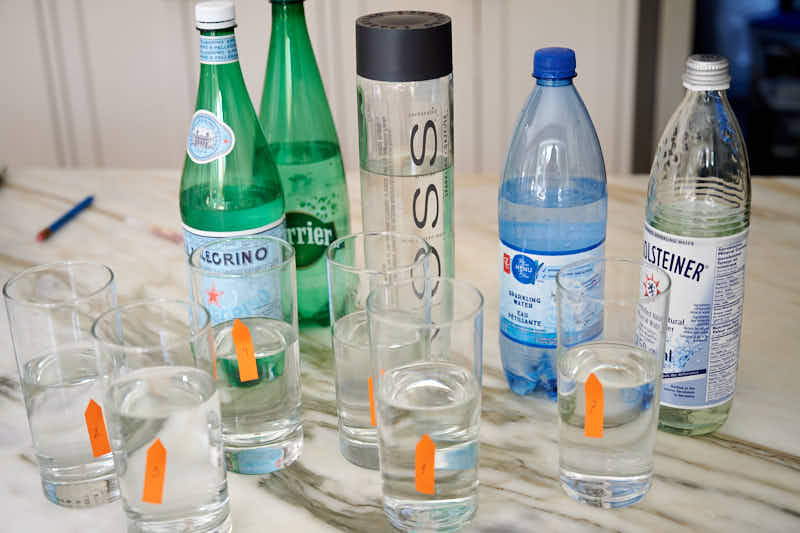
Taste-testing was done by 4 family members. This is a tiny statistical representation and we all are accustomed to the taste of our water so take the results with a grain of salt. But still, this only reinforced my view that this filter produces quite amazingly tasty water. Waterite carbonated water won pretty much unanimously and I think this was not just about the taste but the level of carbonation as well. The number one negative that was identified during testing was inadequate carbonation (e.g. San Pellegrino, Gerolsteiner). Others were a little too salty or a touch too acidic (San Pellegrino and President's Choice respectively). These factors definitely made it easier to pick the home-carbonated Waterite over the competition.
Update on July 11, 2022
Getting a little tired of drinking plain carbonated water? How about some carbonated hard apple cider? So refreshing during summer!
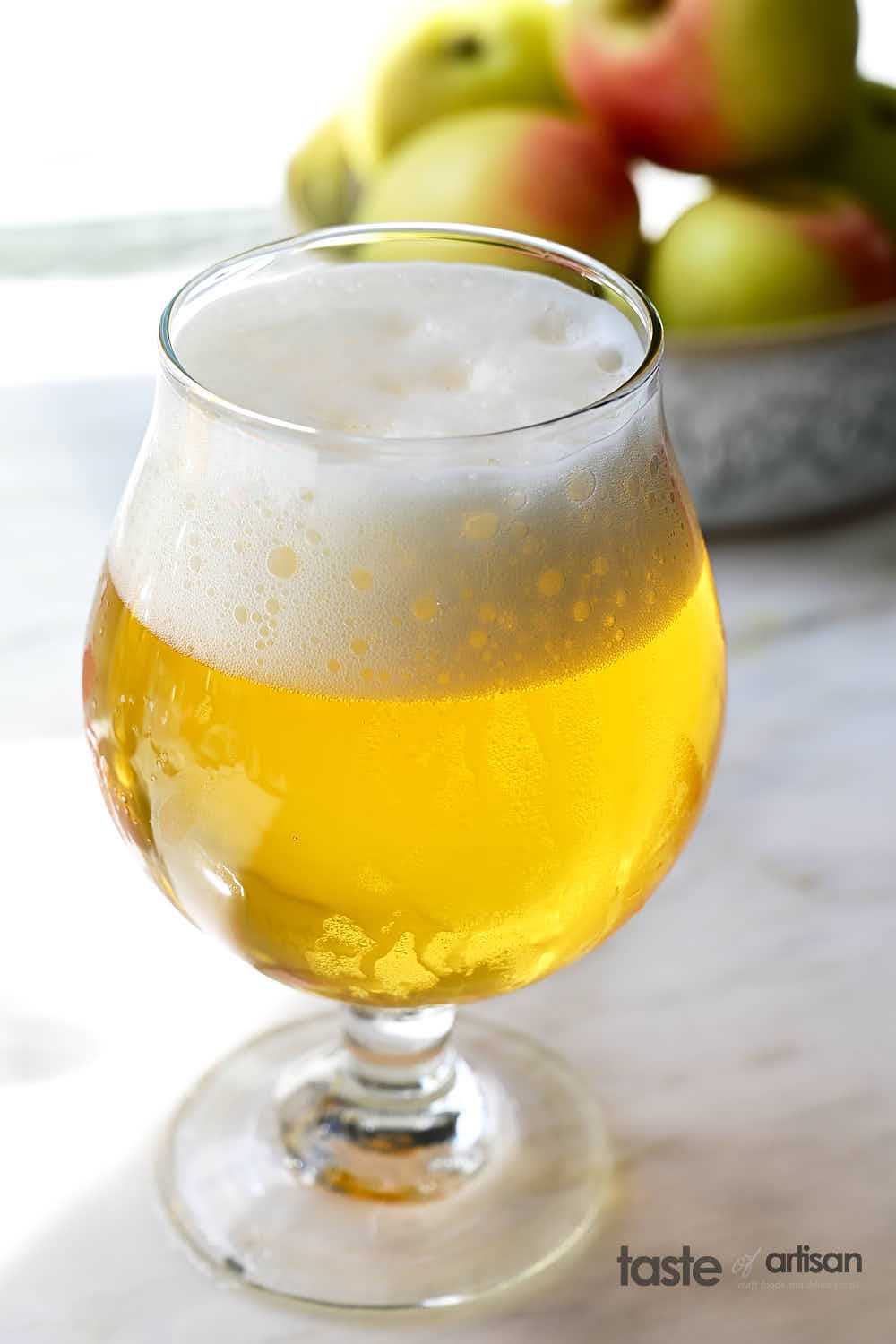


Arthur says
If you are using a soda stream bottle what pressure do you use to carbonate but not explode the bottle? I purchased a tank and regulator and bottle cap adapter, but can't find anywhere the recommended pressure.
Victor @ Taste of Artisan says
I believe I read somewhere that soda stream recommends 35PSI.
Patrick F says
This is an awesome guide - thanks so much!
I used a SodaSteam w/ the SodaMod adapter for a few years and it worked great, but I couldn't find a place to get a 24oz CO2 bottle hydrostatically tested, and now they can't be refilled. I'm planning on moving up to The Carbonator setup instead. I plan on starting with 2L plastic used soda bottles - but have you ever run across a (nicer!) reusable bottle with the same fitting?
Thanks!
Victor @ Taste of Artisan says
Hi Patrick, welcome to the club 🙂 I can't recall where I've seen what you are looking for, but I am pretty certain it was a beer growler. Some have wider mouths, but some are similar to soda bottles. Good luck!
Philippe Tanguay says
Hi, I want to buy an RO system to made sparkling water, i was thinking to buy Home Master Artesian, but i see you switch to iSpring RCC7P-AK, can you tell me why?
Thank You
Victor @ Taste of Artisan says
Hi, it's been while so I can't recall all the factors but I recall if mostly because the specs on iSpring looked better at the time. It's been over 3 years and I like it alot. I really like the powered permeate pump which really speeds up the flow rate. The faucet is better quality with no plastic parts. The setup overall seems more intuitive and easier to assemble/disassemble. But, it's been quite a few years, things may have changed. Good luck picking the right system for you.
John H says
Some equipment vendors are recommending the addition of an air stone diffuser to encourage the gas to dissolve faster. Do you recommend it for making carbonated water?
Victor @ Taste of Artisan says
John, those work relatively well but whether you need one depends on your workflow. For me, I don't need them as I have been running a 2-keg setup for years to have an un-interrupted supply of carbonated water. Having one won't add any value for me. There are also limitations with them. Also, remememebr that water needs to be chilled sufficiently to get proper carbonation at a pre-set PSI. So, it's not like a carbonatin stone/diffuser will magically adequately carbonate water in minutes or even hours. If I want to carbonate chilled water super fast, I shake the keg for 20 minutes. No diffuser will do that in 20 minutes. But, yeah, you will get faster carbonation with it compared to without one, all things bing equal. Pleae read my post from September 19, 2016 at 11:25 am, I answered the same question to somebody who asked me the same questsion. Good luck!
Rick says
I have a kegerator but want to keep the option to use a Sankey connector. Do you know of a corny to Sankey adapter or Sankey kegs that can be filled and sanitized at home?
Victor @ Taste of Artisan says
Rick, I've never used Sankey kegs and know very little about them. Perhaps try beer forums like Home Brew Talk to get more info on that.
Reg says
I have a question.
I left a glass of cabonated water on the counter over night.
In the morning the water tasted sour.
What chemical is left in the glass after all the C02 has disipated?
Reg
Victor @ Taste of Artisan says
Acidic. CO2 mixed with water forms a weak form of carbonic acid. That's what you tasted.
Maran says
Hey Victor!
Just wanted to say thanks for everything you've shared about ways to make carbonated water at home, including your extensive and up to date guide on how to build a kegerator. Last year (Nov 2021) I began with your middle-of-the-road option (The Carbonater): I acquired a CO2 tank from my local CO2 supplier, bought some large plastic bottles, and carbonated the water in the bottles directly. I figured I'd start there to see how things went. At the same time I started to track how much water I was drinking, and created a spreadsheet where I calculated how much I was saving by using the cost of lime LaCroix from Costco as a standard of reference. I also included all my costs in terms of supplies and CO2 fills. Anyway, using the bottle carbonation system I eventually got irritated by how much time I was spending carbonating water and shaking bottles (while carbonating). However, I was having difficulty finding a suitable fridge, especially one that wasn't way, way expensive. But then, lo and behold, one day I decided on a whim to check out the "Business" Costco in my city (Minneapolis) just for fun, to see what they sold there, and what did I see when I walked in? The EXACT Danby refrigerator you include in your kegerator building guide! It was destiny. Now I had a much more cost effective way to go to the next level -- The Kegerator. I bought all the supplies you recommended (which is a bit more than what you paid when you made these guides a few years ago; I assume the higher cost is due to material cost increases and inflation). I felt the higher cost of the Kegerator system was justified because I had already broken even, long ago, on my initial investment in the CO2 tank rental, my initial fills, water and gas lines, and so on. Anyway, I made the Kegerator in May of this year (2022) and I did everything short of adding the keg tap tower. I used that system, with a picnic tap line, connected to my dispensing keg, for four months. I just opened the fridge and dispensed every time I wanted water, no big deal. I also went way into the red for buying the fridge and the (used! whew!) kegs (and a dual valve regulator, eventually, more on that below), so needed to wait to get closer to breaking even. After many more days of carbonated water consumed, and thus having gotten closer to a cost neutral state, I'm so super stoked to say that yesterday I added the keg tap tower and my system is now complete! I even added a Perlick 650SS with flow control. OMG it's amazing. Every step of the way, I consulted your guides. I'm pretty sure I couldn't have done this without you, or even if I did, it would have taken me MUCH more time, and cost probably a lot more money due to buying stuff I didn't end up needing, buying the wrong things, etc. Thank you!!!!
I have some recommendations to others who are considering using the Carbonater or Kegerator systems:
First, if you're doing the Carbonater and carbonating bottles directly, I recommend Topo Chico bottles, they seem to have a little plastic gasket in the cap that keeps the gas from slowly leaking out of the bottles.
Second, if you're looking to build a Kegerator system or even if you start somewhere before that state but think you may go that route eventually: Buy a dual-valve CO2 regulator, not a single-valve CO2 regulator. Initially I purchased a single-valve regulator. This was all I needed, because I was only carbonating one plastic bottle at a time. If you think there's ANY possibility you'll end up eventually making a carbonated water kegerator, it's a no brainer you'll want to do a two-keg system (if you carbonate only one keg at a time, you'll need to wait while that keg is carbonating and will not have your precious carbonated water to drink while you're waiting, that's, like, not even an option in my opinion, especially if you're going through all the trouble of building a kegerator). And if you do a two keg system, it works way, way better to have a dual valve regulator. If you start modest and level up like I did, this may seem like overkill. Just do it. The reason is: with a dual valve regulator (unlike a one valve system with a manifold) you can independently carbonate at high pressure (e.g. 50 PSI) while you have the other keg at dispensing pressure (e.g. 20 PSI). You can't dispense at 50 PSI, and it just kind of sucks to carbonate at 20 PSI. It's ideal to have both pressures. Unless I'm totally missing something, a dual valve regulator is the way to do this. (It doesn't work the same with a single valve and a manifold, because I believe the manifold will equalize between the two kegs, or at least that's what felt like was happening to me when I tried this.) So, just buy the dual-valve initially instead of having to buy a single valve and then try to sell it off to buy a dual valve.
Also, if you're in Minneapolis, MN, recommendations on places to get stuff: Costco Business (in NE Mpls) for the Danby fridge. Minneapolis CO2 (in North, off I-94 on Dowling, they have other locations in the metro, too) for the CO2 tank and refills (refills are $18 for a 5 pound tank). Midwest Supply* for everything (literally everything) else. You can get used 5 gallon Cornelius kegs from them, too.
*Thanks for giving a hat tip to Midwest Supply (somewhere, I can't recall where) in your posts, @Victor! I'm super lucky this is a Minneapolis company, they ship all over North America but I can drive right up to their store and buy things, I live about 10 minutes away from the store. The folks who work there are amazing, they're super knowledgeable. I've been shopping there since the early 2000s.
Victor @ Taste of Artisan says
Hi Maran, thank you for sharing your journey to having carbonated water at home. You are very welcome. I am glad it all worked out well for you. I am sure many will enjoy reading it and especially your tips. I am not sure I am clear on the value of the dual pressure setup the way you want to use it. If you want to carbonate at 50PSI and dispense at 20 psi, it will only work for a very short period of time. With the headspace filled with CO2 at 2OPSI and water carbonated at 50psi, they will begin to equalize and soon your carbonation will drop. The more water you dispense, the more headspace you get, the less carbonated water will get. To keep it at the same level of carbonation you need to dispense it at the same PSI. I don't see a problem dispensing at 50PSI, I carbonate mine at 45PSI and dispense at 45PSI, no problem. I do use a perlic faucet with flow control set to low(er) flow. Now, if you have people in the house who like very carbonated and less carbonated water, then the setup that you described will be good to have. Enjoy!
Sean says
Nice article . My wife drinks a lot of club soda (seltzer as well). I was thinking about getting the soda stream , but the price per litre from the soda stream is just a fractional savings as compared to the litre bottle multi pack I purchase from Costco, even though Costco just increased their price about an extra $1 for the 12pack (I think it $7.50 for the 12 pack. She'll drink 1 to 1.5 litres a day .
So I'm trying to find a cheaper solution and like the carbonator and keg setup you mention. The think is ... How long does water keep in those tanks? Won't the water *spoil* sitting in those tanks for such an extended period ? We're on well water , so we have mineralazation already.
Any help and thoughts would be appreciated.
Victor @ Taste of Artisan says
Sean, making carbonated water at home with own DIY kegerator/carbonator and a large CO2 tank that you can refill at a local commercial soda supplier is about the cheapest way you can go, costing you pennies per liter in ongoing costs. It tastes better too if you do it right. I am sure your natural well water will give most store-bought water a run for its money taste-wise and you can adjust carbonation level to whatever YOU like.
How low will water keep in these tanks? A long time. I don't know exactly how long, but I think many, many months, maybe years. Here is why. First, it will be refrigerated, so any spoilage bacteria, etc. that may get in, won't be able to grow. Secondly, CO2 is acidic. Acidity is another safety hurdle against bacteria, mold, etc. Someone once asked me here how often I clean my kegs. I don't, really. The two kegs that I use smell good and look good. I mean, they don't smell like anything. No bad smell. I haven't cleaned or sanitized them for years. There is no need. CO2 is like a sanitizer. If you use clean water - I use RO water - there is no need to clean them and the water in them won't spoil. Even if some bacteria will get in, as I said, cold temperature and acidity provide an inhospitable environment for them.
Buid that kegerator and enjoy your water. We love ours, we go through a keg every 2-3 days in summer.
Ron Page says
I've got a kegerator setup my first attempt was to make hard seltzer with alkaline RO water and everclear. I've tried various combinations of 20-45 PSI and 3/16" line lengths of 5-35ft. Unfortunately, I've not gotten good results with any combination. The water is usually flat, either coming flat out of the tap or over-fizzing with a resulting flatness.
Can you suggest an approach I should take to produce more carbonation? BTW, I want to also to keep a keg with just plain water if I can get it to carbonate better.
Victor @ Taste of Artisan says
Hi there Ron. Lot's of variables there, let's go step by step.
1. 3/16" tubing is standard, I've been using those for many years, not a factor here.
2. Length shouldn't matter much but I am not sure about long runs as I've never tested anything longer than 5 feet.
3. Temperature - the lower the temperature the better the carbonation. What's the temp in your kegerator? Mine is kept at about 36F-38F and I get very strong carbonation at 45 PSI. Even at 35PSI the carbonation is decent. 20 PSI is not enough to get decent carbonation, you need about 30 at the very least but I'd suggest 35-40 PSI. I carbonate at 45 as we like very carbonated water.
4. Time - how long do you carbonate? In my kegerator, if I fill a keg with room temperature water from the RO system, it takes 48 hours to get full carbonation. After 1 day, I get barely noticeable carbonation.
5. What do you mean by over-fizzling with flatness?
6. If I understand you last question, you want to keep plain water in the keg. You will need to provide some pressure to dispense it. 1-2 PSI should do and you won't notice any carbonation. I clean my beer kegs by pushing cleaners through at about 1-2 PSI. The flow is quite slow though.
To conclude, I'd suggest this:
1. Limit the line to 5ft
2. Set the CO2 regulator to 45 PSI
3. Set the kegerator fridge to 36F
4. Fill the keg with water, connect the CO2 and water lines. Make sure they are connected correctly. CO2 - IN, water - OUT.
5. Let it be for 48 hours.
6. Test the water after 48 hours. If everything is connected/working correctly, you will get perfectly carbonated water.
7. If not, there is a problem with the setup.
Common problems:
1. There is a CO2 gas leak somewhere.
2. Possible but not very likely - the regulator is not working right
3. Gas quick disconnect is not connected correctly, clogged or leaking gas.
4. Gas release valve on the keg is not seated properly. Happened to me once. Lost a full tank of gas.
Perhaps, give your system a good check for leaks from the CO2 tank all the way to the keg before the steps above.
One little tip - when all is working well, when you connect the gas line to the keg you should hear a faint hissing sound for a few seconds.
As well, when you lift the gas release valve on the keg, you will hear a powerful hissing sound from the gas release. Once you close the valve, you will hear a weak hissing sound inside the keg as the gas is filling the headspace.
If you don't hear that sound, the gas is not entering the keg or the gas release valve is not closed properly. You will need to reseat it.
Every time you refill a keg, put a very thin layer of petrol gel on all visible gaskets, that usually is the keg lid gasket and the two small gaskets on in/out quick disconnects. If you don't, you may get a leak.
Hope this helps and good luck.
Nicolas Bulgarella says
I’ve got several Sigg bottles, but after reading this article I think I might add a stainless steel to my collection to see how I like it…Good stuff to think about, Thanks!
Victor @ Taste of Artisan says
You are welcome.
Mike S says
Historically I drink up to 4 liters store-bought (arrowhead flavored) sparkling water a day. I am now about 1 week in, using the carbonator cap & a 10lb CO2 tank. It's a great solution but too fiddly. I've been using tap water run thru a Brita pitcher but not impressed with Brita, so want to install RO. Hadn't considered re-adding minerals before, but may reconsider. Here's the question: I know RO systems usually have a holding tank, but I somehow doubt it has the pressure to fill a corny keg via the water input (continuous carbonation) port-- if you leave the keg at even 40psi. (If I used tap water my city water pressure exceeds that & could work but I don't like the taste of our tap water). This solution is the most elegant IF I can figure that bit out. Also, would an air stone speed rate of carbonization if I went this direction?
Victor @ Taste of Artisan says
Hey Mike, yeah, you definitely don't want to use tap water. In my city, I know a lot people drink tap water because it's apparently 'safe to drink' but it tastes bad to me.
Carbonation stone is kind of a useless invention. With a stone, you need to start with very low PSI and gradually increase it until you hit the target PSI. Too fiddly. I've never bothered with it but I've heard from a few people that overall carbonation time is about the same. Also, if you start with warm water it will need to chill first to reach proper carbonation at the set PSI. No way around it and chilling a full keg of water takes time.
Don't know how well what you want to do will work with an RO system, you'd need to test but it looks like the output pressure on the tank is at about 30-50PSI based on the quick search today. So it may work. If not, I'd use this: https://www.webstaurantstore.com/mccanns-e400397-big-mac-fastflow-carbonator-115v/716CARB0397.html. I've been thinking about this setup but it will need some kitchen redesign on my part before I can do it.
Also, check Joe's recent comment on his setup, perhaps that will work for you. Looks pretty cool.
Karen eldredge says
I have gone through the whole "process" of having carbonated water at home. From cans to bottles then the soda stream, then I got a kegerator and loved it.
Mark Kellogg says
I have a regulator and hose on a propane tank that I no longer need. Can I use this for co2?
Victor @ Taste of Artisan says
Nope. Has to be a CO2 regulator. CO2 tanks have 4x-8x the pressure of LP tanks.
Joe says
I wanted to update you on the carbonation process I'm using and the carbonation lid. First, I switched my CO2 tanks so the 20 lb is on the dispensing keg. It will be doing most of the heavy lifting, filling the 2.5 gal keg to 45 psi when the keg is empty. Since I'm re-using that CO2 the 5 lb tank only has to "top off" the final carbonation. Amazingly, it looks like my idea of dissolving the empty keg's CO2 when making a new batch works! I've done 2 kegs so far... one with the carbonation lid and one filling through the liquid post. I put an empty keg on my scale, then filled it through the lid and found the water shut off at 19.7 lbs of water, just under 9 liters, perfect. The lid filled keg took about 24 hrs to fill, the liquid post filled keg took 12 hrs. Will continue to use both methods until I decide which one I prefer but the lid does work. One advantage is the lid allows you to "set and forget" so to speak, if you are not around to manually shut the water off when full. I also mounted the various components on a sort of carbonation control panel, since everything is manually done and not automated (see attached photo). In the other photo, it shows the 5 liter pre-chill non-carbonated water keg and the 2.5 gal carbonating keg (on the scale) in the refrigerator. I'm really having a lot of fun with this.
Victor @ Taste of Artisan says
HI Joe,
your setup looks really cool, love that digital pressure gauge display and the whole carbonation panel, I think I am going to add something like that too... looks very techy. Nice to know that the lid works... I kind of thought it would if implemented properly... my biggest challenge is getting the water supply to where the kegerator is. Once that's resolved I will give it a go. Definitely love the set it and forget it aspect of it. You could easily switch to a tiny fridge with a 2-3 gallon keg to fulfill all the water needs... bye-bye to huge 5-gallon kegs... it will be a neat setup.
Thank you for sharing this.
Joe says
Thanks for the inspiration for making carbonated water... I followed your guide and I am thrilled with the results. My setup is slightly different, one keg (2.5 gal) is carbonating in our second fridge in the laundry room with a 20 lb CO2 tank outside plumbed through the side. The dispensing keg is in a 2.4 cu ft mini-fridge under our outdoor bar, with a 5 lb CO2 tank plumbed though the top. A Nukatap flow control faucet dispenses through the door. One other thing I do different is I fill the empty kegs through the liquid post. The empty keg has 40 psi CO2 in it. Filtered water goes through a regulator (60 psi), ball valve, check valve and a liquid disconnect. When the ball valve is opened, the higher pressure water comes in. I use the pressure relief to vent the CO2 until I reach 20 lbs weight of water (keg is on an electronic scale) which almost fills the keg and leaves a little headspace. Saves a little gas, and no purging required. The 60 psi keg absorbs the CO2, reducing the pressure until the normal 40 PSI is reached at which point the 20 lb main tank continues to feed gas until fully carbonated.
Victor @ Taste of Artisan says
Hi Joe, kudos to you for putting up such an interesting and creative setup. I might borrow some elements. Ideally, I'd like to have the whole thing plumbed in and automated... there are tools/components, just need time and money to implement this... hoping to have some sort of automation within a year or so.
We go through a 5-gallon keg every 3-4 days or so as it's been pretty hot and humid here and I'd love to not have to remember to refill those kegs all the time. I added a second tank to my RO system so I now have a total of 9.2 gallons, which gives me an effective volume of about 6 gallons or so. Now I can fill a 5-gallon keg within 10-12 minutes. That's quite a relief as before I'd have to fill half the keg quite quickly and the rest would take hours to fill up. Sometimes I'd forget about it and would have to deal with overflows. What a nightmare that was;)
Joe says
I just ordered the reactor lid Dan P mentioned https://www.morebeer.com/products/continuous-soda-carbonator-keg-lid.html. Will run the water line into the fridge. It would speed up the process to have a keg of tap water in line to the carbonating keg to pre-chill the water. Got a 5 liter keg coming for that. If I can use all the gas in an empty keg to carbonate a new batch, that would be great. Will let you know how the lid works.
Victor @ Taste of Artisan says
Yeah, that is a very interesting piece of equipment and I've been thinking about it by at the moment running a water line to my carbonator presents a huge challenge. Do let me know what kind of results you get with it. I think it should work.
Keith says
Why would you want aluminum oxide on your remineralization cartridge?
Victor @ Taste of Artisan says
No intent to have it there, the filter has it and I love the taste of the water, that's all. Now that you asked me, I looked it up... looks like it's not water-soluble so probably not even getting in the water, just happens to be in the natural minerals they use in the filter. No conclusive studies of negative side effects either. Anything I am missing?
ada says
great post, thank you.
we’ve been struggling with our water keg kicking our co2 canister. can’t find a leak using the soapy water test.
we haven’t yet made the move of installing the co2 outside of the kegerator - so have the small tank messily rigged inside.
just using beer and kombucha - a 5 pound tank lasts 10 months.
adding a keg of water it’s gone in a week or two.
your tubing looks much higher quality than mine so thinking of starting there - any other obvious places to focus?
Victor @ Taste of Artisan says
Hi ada, a leak can be just about anywhere but the connections are the obvious places. Sometimes it can be damaged tubing. Hey, if you really want to have a quick solution and since you haven't run tubing through the fridge yet, it should be simple - take the keg with the CO2 tank out and submerge in water (like in a bathtub) piece by piece. So, the top of the keg with the disconnects and part of the tubing goes in first, check for bubbles. Then the CO2 tank up to the inlet nipple on the CO2 tank, do not submerge the gauge(s), then the tubing connected to the CO2 regulator all the way to the shutoff valve, again, not submerging the gauge(s). I've done it myself once to find a pesky tiny leak.
d says
You should look at this pony keg lid that allows you to plumb in a line from the house water, so you don't have to care about filling the keg anymore: https://www.youtube.com/watch?v=XIEni6GuhQU
Stephen says
Do you use any keg sanitizer or cleaner like star sans ever? Trying to see if that no rinse stuff will leave a bad taste?
Victor @ Taste of Artisan says
I do clean/wash my water kegs every once in a while, like every 2 years. They do surprisingly well without, I check them periodically, there is never an off smell or anything. I think it's because the RO water is clean and carbonation acidifies the water so which creates a natural hurdle for bacteria growth. C02 is antibacterial. I use PBW to clean my water kegs but don't sanitize them, no need. Give them a nice rinse after PBW, that's all. Beer kegs and carboys, yeah, those get sanitized. Starsan doesn't give off any off taste/smell, use it for beer kegs all the time.
Dan P says
in reference to pre plumbing a water line to always keep you keg full with water, would this item from keg land work, he claims that your keg top has a float to fill when it gets low. not sure if you experimented with this, or do you feel that once still water is added you pre carbonated water it would dilute your amount of carbonation? here is a link to it. would love to hear your thoughts.
https://www.kegland.com.au/soda-carbonator-keg-reactor-lid-continuous-soda-water-solution.html
Victor @ Taste of Artisan says
Hi Dan, that little gadget looks freaking awesome if it works. Does it? I wouldn't know without trying. It's obvious that you need to supply water at a higher PSI than you are carbonating. So, if you carbonate at 45 PSI and your water pressure in the supply line is below that level, the water won't get in the keg. You may need to drop the carbonation PSI and settle for a less fizzy water. You also have to have some sort of a backflow control valve on the supply side, which, looking at the picture, it seems to have. I would definitely try this product, looks like it may actually work. I am thinking of ordering one to play with though I have yet to run a water supply line to my kegerator, not as easy as I thought it would be in my kitchen. Thanks for sharing that link.
Rick says
Thanks for this. Would it be possible to skip the step of converting the small fridge into a kegerator and just take out all the shelves and leave it as a fridge? Then instead of a tap, maybe run a line from the keg to a picnic faucet. I know this way I'd forego the pleasure of having a tap, and would have to open the refrigerator each time. One question would be if an unmodified 4.4 cu ft refrigerator is large enough to fit two 5-gallon kegs and a CO2 tank. If it would fit one keg and a 5-lb tank I'd be OK with that.
Victor @ Taste of Artisan says
Hi Rick, apologies for the delay with my response. Two 5-gallon kegs and a 5lb CO2 tank fit fine in my fridge as long as I have the following mod:

See more in my kegerator build guide.
Rick says
Thanks for this great post. Is there any reason I can't modify the Kegerator solution by *not* converting a 4.4 cu ft bar fridge to a kegerator but just leaving it as it is and keeping the keg(s) and CO2 tanks inside? I know I'd be foregoing the coolness of having a real tap on top, but when I want my water I'd just have to open the fridge door and pour it from a picnic tap attached to the keg? Would that work?
Mike says
Great article, very comprehensive. I’ve got a nearly identical setup with a pair of corny kegs in a kegerator. Im going to try your recommended Waterite filter.
A few things I’ve found over the years:
1. A tower cooler give a colder 1st pour, less loss of carbonation during pour, and also circulates air in kegerator and keeps lines from freezing even if near cooling plate.
2. EvaBarrier tubing is great. No taste, low cost and small diameter so you can have 15-20ft of beverage line which helps with slower pour and less loss of carbonation. Hookup is a breeze with John Guest or DuoTight fittings.
3. I found Apex flavors are very good and have worked well for adding into the kegs. There isn’t any sweetener in them so I don’t have to clean or sanitize kegs between refills. Tangerine is my families favorite.
4. I saw some folks asking about a continuous flowing water setup. I have been thinking about trying this device myself:
https://www.williamsbrewing.com/Home-Brewing-Equipment/Kegging-Equipment/Keg-Parts/Keg-Interior-Parts/Copy-of-Bevelled-Plastic-Gas-Dip-Tube
5. Finally, I’m not sure how true it is, but I have read that seltzer water can leech chemicals out of the brass on chrome plated taps, so you should make sure that you are using stainless steel on non-beer tap hardware.
David says
Thanks for this! We've gotten hooked on Perrier during Covid, despite how much we hate Nestle for their water theft. I can see a kegerator in our future.
Victor @ Taste of Artisan says
My family couldn't live without one. We've got so used to it now that we can't imagine a day without the carbonated water. Check my latest update, those re-mineralizing filters are fantastic and make RO water taste very, very good.
John says
Hi,
I’ve been making soda water with my kegerator set up for about a year and up until this past week it has been fine. I have two five gal kegs that I pressurize at the same time at about 38-40 psi. My kegerator is also at a temp of around 39-40 degrees. Last week i went to get some water and it wasn’t very carbonated, almost flat. I thought the gas ran out or it had a leak, but not the case. Keg was pressurized and still had gas. Nothing seemed off. Checked again in the morning and still the same. I switched to the other keg and same issue. Any thoughts on what maybe going on?
Thanks.
Victor @ Taste of Artisan says
Hi John, that is very strange. But there should a very simple explanation to it. First, make sure that all the valves along the line are fully open. I know, this sounds stupid but stranger things have happened to me. I switched out a CO2 tank once and accidentally pushed the shutoff switch on the regulator to 'off' position. Took me a while to figure that out. The keg may be pressurized but that's from the leftover CO2... if no new CO2 is supplied, carbonation will be dropping as you use more water.
There can be a leak along the line somewhere. If someone kicked the hose, that's a possibility and it can be anywhere.
Finally, the CO2 regulator may have malfunctioned. Regulators have a "shut down" safety system (blow off at 55 PSI or so). It's possible that the issue could be related to that.
To troubleshoot, I'd personally check the line from the CO2 regulator all the way to the keg and make sure all connections are fine, well seated and all valves are open. Then, if still having a problem, I'd turn the switch to OFF on the regulator, disconnect the hose going from the regulator to the manifold/tank, cover the opening with the finger and turn the switch on. You should feel the pressure/CO2 release if the regulator works fine. If not, then you know it's the regulator. Hope this helps.
john sanchez says
Hi Victor, so I checked the lines, connections and valve. Everything looks good and normal. I disconnected one of the ball locks and turned the gas on, and it was flowing. I then purged one of the tanks and reconnected it and will wait 48 hours or so to see if it has good carbonation.
The only other thing that I can think of is that I keep my kegerator in the garage and it’s colder now, but that shouldn’t matter. Besides I had it in there last winter.
Anyway will see what happens after a couple of days.
Victor @ Taste of Artisan says
It could be/have been a weird glitch. Like maybe some water got inside the keg's gas dip tube and froze in there. Totally possible. Improperly seated connector maybe. The temp drop in the garage will have a negligible effect on the carbonation level in your case. At room temp, the pressure inside the CO2 cylinder is about 837 psi. In a cold garage, there will be a drop in PSI but it won't get anywhere near the 40 PSI you carbonate at, so there will be no effect on the ability to carbonate. What WILL have a significant impact on the carbonation level is the water temp inside the keg... but that did not change.
Victor @ Taste of Artisan says
Updated the article (scroll to the bottom) with some exciting taste test results. Quite interesting how an alkaline filter can make RO water either incredibly good or barely drinkable.
Dennis says
Thanks for the very insightful post. I was seeking alternatives to Sodastream and Drinkmate and found your post.
For the Carbonator, would this $140 kit from AliExpress be similar to what you've described?
Thanks.
Victor @ Taste of Artisan says
Yes, similar only it comes with a 5 times smaller water tank and 1/5th of an already tiny 5lb CO2 tank. I use 5-gallon tanks and a 20lb CO2 tank.
Hannah says
I've been collecting all the supplies I need to keg water and am finally ready to start. Have you tried to flavor the water?
Victor @ Taste of Artisan says
Hi Hannah, yes I tried flavoring water but quickly stopped that as we go through kegs quickly and they need cleaning and sanitization if using certain flavorings... too much work. I find it easier to just add flavourings in the glass. I tried to flavor my water to get the 'Perrier' flavor, my favorite is grapefruit flavor but I could not replicate that... Natural (filtered) juice and rind oil only made water cloudy... Anyway, not flavouring in kegs.
Dan says
I was wondering if the Kegerator solution would work with a water line feeding into the kegs? Maybe have Keg A receive water from the source, receive carbonation from the tank, feed carbonated water into tank B, tank B receive carbonation, and tank B provide carbonated water to the user. Doable or no? Just thinking it would be nice to find a solution that wouldn't involve swapping out water kegs.
Victor @ Taste of Artisan says
No, that won't work. What you need is Big Mac motor carbonator system. This will give you exactly what you need. I am going to upgrade my setup to include the Big Mac motor carbonator system in the near future and will update the post on how it goes and what results I get.
Simon says
I have no idea what a Big Mac is needed. Even two kegs aren't needed. Pic shows my single, permanent 9L tank in main kitchen fridge, water line straight in without any pump, just mains pressure. CO2 also going in, tap coming out. Continuous carbonation, tank refills automatically. Easily dispenses my 4L per day and likely could do double that. doesn't.
https://i.imgur.com/kcY9t8x.jpg
Victor @ Taste of Artisan says
Interesting. But how is your carbonation? My assumption has always been that a carbonation level can only be maintained in a closed system. Once you open it (water line in without a valve), wouldn't CO2 escape, essentially trying to carbonate the whole water line? I never tested this though but I will as I am intrigued.
John Strube says
Definitely look into a commercial style system like the Big Mac. You can get rid of the tanks, and just run the carbonator pump with small storage tank. Probably would be cheaper than the kegs were. This is what the "big boys" of drink dispensing moved on to, at least 30 years ago. You only need to keep the hose cold. I had a summer job back in 1987 where we installed these systems and serviced them. Back then, I put together a home beer dispensing system, now, I am looking to do fizzy water. 1 trip to Italy where they drink it all the time was all it took!
Victor @ Taste of Artisan says
Oh, I am:-) already planning to get one. I want to put it in a very small bar fridge. I am quite impressed but this little device.
Alejandro Barreda says
You need to add the Big Mac motor carbonator system, I just installed one in my kitchen, best thing ever, Seltzer on tap unlimited amounts.
Took me around a week to find all the parts and fittings, really worth it.
Victor @ Taste of Artisan says
Hi Alejandro, thanks for this valuable piece of information. I've never heard of this system but it looks really cool. I am definitely going to investigate and hopefully test it out. Not having to deal with refilling water tanks is a welcome upgrade. Besides, you can get away with a much smaller fridge to keep the water cold.
Simon says
I only use 10% of my kitchen fridge for a single 9L keg costing $50, lines from water mains and CO2 tank which sits out of site on top of cupboards above fridge. Single line out to dispensing tap sitting outside the fridge. Easily keeps up with my 4L a day, I suspect I could even do 6 or 8L. Automatic refilling as it's used.
Big Mac - it's big - I have the same rotary pump and similar regulator for my coffee machine. So not the sacrifice of fridge space, but still cupboard space. $500, power required, external chilling still required if you like it cold. Would be cheaper to run though than keeping 9L cold - not sure if trivial though.
Plus I can detach the 9L keg in seconds, take it straight to a party with the dispensing tap with some 16g CO2 cartridges to dispense.
Wout Mertens says
Hi, thank you for your thorough explanation!
I was wondering why I can't find any system where you just hook up a CO2 tank to a water source, given that I'm totally fine with the temperature and taste of my tap water. Is there a problem with getting the water to mix in time? My SodaStream carbonates in 2s so it seems like it should be possible?
Many thanks for your insight!
Victor @ Taste of Artisan says
Well, I've been asked this question several times. While it seems like a good idea, it's just not physically possible. A C02 carbonation system is a closed system. In it, you have a balance between CO2 gas pressure and the amount of CO2 dissolved in water, which is also a function of temperature. As soon as you open up the tank to a water source, you will be making it a part of the system. It will affect the temperature inside the keg and the carbonation. In essence, you will be carbonating your water source as well. I am not an engineer so I may be wrong about this, but what you are looking for is not technically possible. Not easily anyway.
JOHN R SANCHEZ says
Hi, thanks again for your detailed instructions on making carbonated water. I finally got started on my and decided to buy a kegerator instead of making my own. Have a couple questions though. After you’ve achieved your ideal water at 40 psi for 48 hours, do you dial back the psi? Also, if you’ve carbonated a keg, can you take it out of the fridge for a period of time? Will it hold its carbonation for awhile? I was wondering because I have a double tap, and may want to put a keg of beer in there sometimes. Thanks
Victor @ Taste of Artisan says
John, no, you don't touch it ever again. You see, when you let some water out of the keg, the extra headroom will have to be filled by gas. It will come from either the CO2 tank, or from the water. If no CO2 is supplied at 40 PSI, the more water you draw, the more CO2 will leave the water to fill headspace, the less carbonated water will become.
>
Can you take a carbonated keg out? Yes, you can. Will it hold the same level of carbonation? No, if the room is warmer than the fridge. Carbonation level (measured in volumes or grams per liter) is a function of pressure (PSI) and temperature. If you carbonate your water to 5 volumes at 40F and move the keg to 70F warm room, over time the carbonation level will drop to what it would have been if you carbonated at 40 PSI and 70F, roughly 3.2 volumes. How quickly will it happen? About as quickly as it carbonates. So, if you carbonate over 48 hours, it will take about 2 days to decarbonate to the point wheRE the carbonation stabilizes. If you shake it, it will carbonate/decarbonate much faster. I once fully carbonated a keg of cold water in 25 or so minutes by shaking it and rolling it around.
Stephanie says
Would this keg system work outside of a fridge? We don’t drink our bubbly cold, but does it have to be cold to effectively carbonate? Thanks.
Victor @ Taste of Artisan says
Stephanie, yes, this system will work outside of a fridge. However, you need to keep a few things in mind. You are correct to suspect that water may not effectively carbonate. It depends on your ambient temperature and the level of carbonation you want to achieve. But you can design the system with that in mind, so it will.
>
Carbonation in liquids is measured as volumes (or grams) of C02 in a volume of liquid. For example, we carbonate our water at 40F and 45 PSI. This results in about 5.5 carbonation rating. We settled on this temperature and carbonation level after some experimenting and consider this ideal for our taste. On the other hand, Perrier, favorite carbonated water of many (I used to love it too), carbonate their water to 3.5 volumes. I can't be 100% certain about this information but this is what I was able to find to give you a frame of reference.
>
Now, say your ambient temperature is 70F. To get 3.5 volume carbonation at this temperature will require about 44 PSI (using this keg carbonation calculator). That's easy to achieve. To get 5.5 volumes at this temperature you will need to increase PSI to 76! My regulator is rated 60 PSI, which means that its pressure relief valve will blow off at 55 to 60 PSI. It's a problem for your application, if you want that level of carbonation, but it can be solved by purchasing a high pressure C02 regulator, like this Taprite 0-120 PSI regulator. If you go the high pressure regulator way, make sure that the C02 hose is also rated to support that pressure.
Marianna Eros says
I have been using sodastream because our tap water has chlorine, fluoride and other chemicals that I don't like so we have a Santevia Filter to filter our water first. Unfortunately it is difficult to find components that allow a CO2 tank to be hooked up to the sodastream refills. The paintball containers are too small and need to be refilled too often. Has anyone found a reliable attachment for the Sodastream cylinders to be able to fill them from a CO2 food grade tank?
Janina says
Thank you so much for this thorough write up. I just purchased 2 new corny kegs and all the supplies I needed to set up a home carbonation system. Very excited. ONe thing you did not mention that I am now wondering about. How do you initially clean the new corny kegs and also, once your keg is empty again, do you first clean and sanitize it before you refill with water?
Thank you so much. I can't wait to drink my own seltzer water.
Victor @ Taste of Artisan says
Hi Janina,
One common way to clean new kegs that may come with machine oil residue is to use Five Star PBW Cleaner. You prepare the solution as per the instructions on the container, fill up the keg, let it sit for 30 minutes then rinse with water several times. I push the solution and later the water out with CO2 to make sure the tubing gets cleaned up too. The same cleaner is commonly used to clean kegs later on, especially if you use them for beers, ciders, etc. This is what I do. Though, my kegs (new, Italian made) came pretty clean and I did not detect any oil residue inside or outside.
Another way I know many clean their kegs with is B-Brite Cleanser it's safe to use on all materials and contains no chlorine. Never used it but heard a lot of good feedback.
For sanitizing Star San is the best product out there, I've been using it for years.
After the initial cleaning and sanitizing I repeat the process very infrequently, maybe once a year or even longer. The reason is that we use RO filtered re-mineralized water, without any flavorings. There are no sediments or residue as a result. Both kegs and the water stay cold in the fridge. Carbonation drops pH. All of this pretty much prevents any bacteria growth. We check the kegs every time we refill them but they usually look pristine, have no odors, and don't seem to need any cleaning.
Joel says
Is there a maximum amount of feet that you have to have between tap/tower and the kegerator? I'm asking because I would like to have the tap at kitchen sink and all the equipment one floor below in the basement. Thanks!
Victor @ Taste of Artisan says
Joel, no, there is no min or max length requirement (unlike when dispensing beer) but keep in mind that whatever length you plan on having outside of the kegerator the water in it will get warm. You won't have less carbonation there but your first glass of water will be warmer.
Tyler says
So, does this sparkling water keg have to be plumbed to a water line? Or do you fill the water tanks individually when need? I'm considering this, but not sure if I can get water to it. Thanks
Victor @ Taste of Artisan says
Tyler, this is an interesting question and I think someone already asked me about the same thing a while ago. The simple answer is that you have to fill the tanks then pressurize them with compressed C02. I haven't seen kegs that can be plumbed in to a water line. I don't think a system like that exists. Even if one does, I don't think it will be sufficiently affordable for a home user.
Jason says
If you want a plumbed system than you're talking about a motorized carbonator and cold plate, probably at least $1000. The cold plate will need a source of ice as well. You can get chillers that don't use ice but they are even more expensive. This is what feeds commercial soda fountains, soda guns at bars, etc.
Victor @ Taste of Artisan says
Thanks for the info, Jason. Gets pretty expensive... But frankly, I've never felt the need to have my set up automated.
Brian says
Where exactly in the Danby 4.4 fridge is the best place to drill a hole for the gas line and the water line? My beer tower will be located on a quartz countertop above the fridge. Thanks.
Victor @ Taste of Artisan says
Hi Brian, apologies for the later response, your comment was lost in the pile of spam comments. If your tower will be raised above the fridge, you might as well drill a smaller (perhaps 1 inch) hole in the top of the fridge similar to where I did and run both gas and water lines through it. Plug any remaining open space with some insulating material. Alternatively, run the water line through the top and the gas line through the bottom, making holes just big enough for the lines to fit through, then cover any cracks with silicone. You can see what I did on the picture under Update on July 3, 2016. You can also see more details in my kegerator build post. Hope this helps.
Wentworth says
Lots of good info. Thanks! I too was considering making my own carbonation system and like a lot of my projects - my wife got fed up with waiting for it and bought a Soda Stream. Now that we have one I was wondering about how it works. On the Soda stream the bottle is removed after pressurizing and is open to atmosphere until you put the cap on it. I'm surprised that most of the CO2 doesn't escape before you put the cap in place. I was wondering why you wouldn't have a check valve of some sort on it. Perhaps for safety reasons? Maybe having a lot of CO2 escaping in the process was better than dealing with a pressurized caps?
One other thing I noticed. Drinks are carbonated with 'beverage grade' CO2 (ie. pure enough to ingest). Is a paint ball CO2 beverage grade? I'd be concerned with using industrial grade gases in my food.
victor says
Hi Wentworth, the reason for that two-fold. One - it's much cheaper that way. For big companies like Soda Stream, saving even a penny per unit adds up to a large sum at the end of the day. I don't think they care if you loose a bit of carbonation. The other reason - it's not that important. Think of CO2 gas as another soluble ingredient, like salt. Put a bunch of salt in water, stir - and it will get dissolved. Let the salted water stand for a while, and some of that salt will solidify again and become a sediment. The same is true with CO2 gas. It will get dissolved in water, much like salt. To reverse, it will take time. The higher the pressure, the colder the water, the larger the area of contact between the water and the CO2 gas, the higher the rate of carbonation will be. The reverse is true too. To lose carbonation very quickly, you'll need to raise the water temperature, decrease pressure and shake the bottle madly. In reality, you are only decreasing the pressure to the level of atmospheric pressure. It will take hours for the water to loose all that carbonation in those conditions. Put a cap on the bottle right after carbonation and little of it will be lost. Refrigerate the bottle and even less will be lost. Leave no head space, cap on, refrigerate, an barely any carbonation will be lost.
To be honest, I've never had a chance to investigate the quality of CO2 gas supplied at paintball shops. I do know that many people use conversion kits and refill at those places. You need to ask at those places. The purity of CO2 gas they use will likely vary from place to place. You bring up a very good point though. When refilling soda stream or other gas tanks, one must always inquire about the quality of the supplied CO2 gas.
Ben M says
Have you ever carbonated directly to glass? Seems like carbonating into a glass San Pellegrino container should be safe, no?
victor says
Never tried that and don't know how effective (or safe) that method would be.
Zetta Viteo says
Thanks for sharing !
jeff d witscher says
Hello Victor love the article I'm just curious as to what would be the best way to bottle the water without losing the carbonation. Is it possible using the carbonator system to bottle quickly enough to preserve the carbonation and then be able to store it at room temp. Is it possible to literally use the carbonator system and then cap them by hand and have a effective tasting water? This would be for 12oz glass bottles using crown caps. Thanks!
victor says
Jeff, bottling water and manually capping by hand will be just as effective as any mechanical method.
It helps to think of carbonated water as water in which CO2 gas is dissolved. The level to which CO2 is dissolved in said water is a factor of 1) temperature and 2) pressure. It also helps to realize that carbonation (and de-carbonation) process is fairly slow on its own (no shaking or other physical intervention). So, if you take sufficiently carbonated water at sufficiently low temperature it won't lose any significant amount of carbonation during transfer from the carbonator to a bottle.
A few more things to keep in mind:
Once in a bottle, at room temperature, the water temperature will go up, forcing CO2 out of the water. The pressure drop will also cause the water to lose carbonation. The two are connected and will try to find equilibrium. Meaning that if you fill a bottle with fully carbonated water all the way to the top, leaving very little or no head space, and provided the cap provides a perfect seal, you won't lose much carbonation even as water temperature will be going up. Fill that bottle half way and you will notice a significant drop in carbonation over time - CO2 will be forced out of the water to fill out the head space until the pressure in the head space and the water are equal.
In practical terms, I can only speak to storing carbonated water in double walled beer growlers. We use three of those at home, one 64oz and two 32oz ones. I fill them out all the way to the top and the water. We usually take them to work/school with us. When I open mine typically 3-4 hours later, sometimes even longer than that, the water is still cold and fully carbonated. Towards the end of the day as the water is consumed, the carbonation level drops but you still get a fairly decent amount of carbonation. In plastic bottles, as the water is consumed, you will be losing carbonation at a faster rate as the water will be increasing its temperature much faster than in a insulated beer growler.
Derek says
Just wondering if you have to turn off Co2 once the kegs are carbonated?
victor says
See my comment above (second part of it).
Derek says
How do you know when the keg is fully CARBONATED?
Do you then have to shut off the Co2 TANK?
victor says
48 hours is what it takes for us to feel like the water is fully carbonated. 24 hours - it feels way under-carbonated, 36 - almost there... you get the point. The timeline assumes room temperature water to start and no assistance like shaking or using carbonation stones. If the water is cold - 40F or below I can fully carbonate a keg by slightly underfilling it and shaking for 20-30 minutes. I did it a few times then got a second keg - problem solved.
I don't shut off the CO2 tank, that's unnecessary - once the water is fully carbonated an equilibrium is maintained at all times. If you do, pressure will fall as water is consumed, leading to lower water pressure at the tap (progressively slower pours) and loss of carbonation.
ALZ says
You had mentioned that you have an active carbon filtration unit which would negate the need/benefit of the activated carbon sticks (Kishu Bichotan) sort of like this:
https://www.amazon.com/Binchotan-Charcoal-Personal-Sticks-Filter/dp/B00RY18XOS/ref=sr_1_4?s=home-garden&ie=UTF8&qid=1505136362&sr=1-4&keywords=Kishu+Binchotan
And that you thought it might be 'tricky' - I'm just curious what might make it tricky. I guess there's a risk of pieces of it breaking off and getting stuck in the system but my understanding is that the sticks themselves are pretty substantive.
Thanks
victor says
Oh, I see. The tricky part is have it fit in the system, large or small, not interfere with carbonation process, cleaning, making sure the water is purified in time, etc. Too many variables. And like you said, they are quite large. My preferred choice is to use clean water to fill the tanks so I have no need to incorporate carbon filtration into the system. However, there is an easy solution, you can simply use the carbon stick to remove impurities from the water before using for carbonation. So, they won't be a part of the system per say, but will be a part of the purification stage prior to putting the water into your carbonation system.
John says
I built The Carbonator rig as described in this article and it works great! I carbonate at about 45 PSI. Right now, I'm carbonating standard 16.9 oz bottles of tap water (fortunately, we have pretty good water, here). My technique is:
1. Pre-chill water in fridge to just above freezing.
2. Apply carbonator cap loosely, burp air out of the bottle, and tighten cap.
3. Carbonate at 45 PSI, shaking gently for 20 seconds.
4. Loosen carbonator cap and burp CO2 out of bottle. Re-tighten cap.
5. Continue carbonating, shaking gently for 15 seconds.
6. Remove carbonator cap and cap bottle and return to fridge.
I found (quite fortuitously) that this produces excellent carbonated water, with plenty of "kick" to it. A very refreshing drink, indeed.
Turns out this is really easy to do, and the payoff is well worth it. All the parts, new, were only about $150 (everything is available on Amazon). Carbonating individual 16.9 oz bottles, while convenient for consumption, is a bit time-consuming, so I may graduate to the larger soda bottles eventually, and ultimately, a draft setup.
victor says
Awesome to hear that, John. Thanks for the feedback on your experience with building your carbonator.
ALZ says
I have excellent tap water so no need to filter. What would you for see being tricky?
thanks
victor says
ALZ, I can't seem to understand your question, perhaps you can try re-phrasing it for me.
ALZ says
Wondering if you've ever experimented with activated charcoal in your system? Sort of like the Kishu charcoal you see in water pitchers.
victor says
Well, it is a part of the chain, not the carbonation system. I use RO water which uses a charcoal filter as one stage. In the system itself it will be tricky.
Rob says
Cool. I think I got all my supplies ordered using your guide. Thanks a TON! I'm excited to build and hope it works well. I got the KegcoPerlick 650SS single faucet...I assume that the vinyl tubing attached is capable of handling the 40+PSI that will be used for Seltzer water?
victor says
Right on! It will work well, don't worry. The tubing that comes with the tower is fine.
Rob says
Quick question about filling the kegs. Is it important to fill the kegs completely full of water (to eliminate any non-C02 gases? Or will having a bit of trapped 'normal' air at the top matter? Just wondering what the process was for refilling an empty keg and if there are any tricks that should be followed to get the best/quickest carbonation.
victor says
No, not important in any significant way. You don't want to fill all the way anyway otherwise your gas tube will get flooded with water, you don't want that. Shaking the keg will give you the quickest carbonation, but if have a two keg setup like mine that is not an issue. Using a carbonating stone will also speed up the process but it a bit involved, not set it and forget it.
Derrick Truitt says
Has anyone implemented a McCann's carbonator to their system? I just picked one up (practically brand new) from a used restaurant equipment store for $115.. so I'm thinking of using your same system but including the carbonator. Any suggestions/concerns with using this carbonator?
Thanks
Jonathan Jacobs says
Thanks so much for this great guide. Quick question (I hope it's quick). If i buy the Edgestar kegerator like you have listed in your post, it looks like I could fit 2 sixth kegs in it. How much more modification would I need to do to make it a relatively seamless dual system (so I never have to wait 48 hours).
Thanks! Amazing post.
victor says
Jonathan, the Edgestar that I linked will fit 2 5-gallon kegs that I am using and that you see on the pictures in my post. You will not need to do any additional mods to the kegerator itself. What you will need is to add a 2-way manifold or a 2-Way Secondary Regulator, either one will be inside the kegerator, between the CO2 regulator and the keg.
Check out my post on How to Build a Kegerator, I have a picture of my kegerator that uses a secondary regulator. You will only benefit from a secondary regulator if you want to keep pressures at different levels, otherwise use a simple manifold. If you are like me and are trying to think ahead, get a secondary regulator, you may need it later if you decide to experiment or use it for dispensing beer, cider and what not.
Akos Ulrich says
Hi Victor,
Great article, thanks a lot for sharing your secrets!
Could you give me any advice in making carbonation as quick as possible? I am using a full 5 gallon Cornelius keg with a CO2 tank to carbonate water (actually tea).
I've heard of methods that say I should shake the keg several times.. Does it really help?
Thank you,
Akos
victor says
Yes, 10 minutes of shaking the keg will carbonate it pretty good. Mind you, the water will need to be cold otherwise shaking won't be as effective. Also, try to fill it about 3/4 of the way, that will help carbonate it better using the shaking method.
Bob DeSilva says
My tower will be about three feet from the refrigerator. Is it as important to cool the tower for carbonation as it appears to be for beer?
victor says
Well, foaming ain't gonna be a problem that's for sure;)
Carbonation-wise it should be totally fine. Temp-wise, well, assuming you will be using the standard tube that comes with a tower, that's 1/2 oz of liquid (3/16” ID = 1/6 oz liquid/ft) sitting in the tube... even fully unchilled sitting outside a fridge, it will have minimal impact. Unless one likes 1-oz shots of carbonated water. Even then, only the first one after a long period of no use will be affected.
Bob DeSilva says
Can you fill empty Perrier bottles from the tower and refrigerate? Will the carbonation last?
victor says
Yes. CO2 dissolves better in cold water, so the colder the fridge the longer carbonation will last. Fill the bottle all the way up, close real tight and the carbonation will last a long time. How do I know? My wife takes one of these Klean Kanteen Insulated Growlers to work every day and the water stays cold and well carbonated for the entire day. As water is used and the temperature is increasing slowly, carbonation decreases as well, but not dramatically. Closed tight, in a cold fridge I would guess it will stay carbonated for a very, very long time.
Renee says
Thanks for the very thorough post. My husband built a kegerator and then upgraded to a 6-tap keezer, under the condition that I get a water tap. We use an RO/DI filter for all of our drinking water. We have tried both an stainless keg and a disposable plastic keg, but both produce seltzer water that tastes terrible! He cleaned the kegs thoroughly before filling with water. The water tastes great in the kegs before carbonation. We can't figure out what is making the carbonated water taste bad. Any advice?
victor says
Hm, an interesting but very subjective question. 'Tastes bad' can mean very different things to different people.
Regardless, it will be practically impossible to give you a solution without some troubleshooting. You've already done some. You've eliminated the keg. That's the first step.
Now, investigate the water. You said that your filtered tap water tastes great. That's fine. Can you try to carbonate one keg with good quality spring water (sold in 5-gallon bottles)? See if the minerals in the spring water make a difference. DI water, some say, does not taste very good. Perhaps carbonation amplifies the qualities of de-ionized water? I don't know, technically it's possible. My water filter has a re-mineralization stage. Does yours have that too? The added minerals make a very positive difference to the taste.
Carbonated water is acidic. Carbon dioxide and water react chemically to produce carbonic acid, a weak acid that’s been shown to stimulate the same nerve receptors in your mouth as mustard. The pH of carbonated water is 3–4. Perhaps, you don't like the acidity and that's what you described as tasting terrible? Does plain Perrier have the same taste quality to you? Plain Canada Dry carboanted water? If not, then it's not the acidity.
Level of carbonation. Are you tasting fully carbonated water? My wife doesn't like the taste before it's fully carbonated. 2 full days at 40PSI in the fridge is what it takes for me to consider the water fully carbonated. What PSI are you using? Try to experiment with 30PSI, 35, 40 and as high as 45PSI. Does that change how the water tastes to you?
Finally, I would look closer into that what your gas supplier puts into your CO2 tank. If their CO2 gas is mixed with some other gases, that could lead to off tastes. Try a different supplier and see if that makes a difference. I know people refill their CO2 tanks at welding shops and what not. I do mine at a place that services restaurant and hospitality industries, and fills the tanks with what they call Food Grade Certified CO2 "POPGAS".
And just to be sure one more time, I lined up my wife and the kids next to the kegerator, poured a glass of water for each and asked them to taste it and tell me if there was anything about the water they did not like. They couldn't come up with anything. Everybody said they loved it. LOL. I have to refill a keg every 3 days, every two days in summer. There is the answer:-)
P.S. Would love to know how your troubleshooting goes and whether you get acceptable results. As, I am sure, many others too. Let us know.
Nick S says
So it seems like the options are a tower w/ a Perlick 650SS tap, a stout faucet, or a cheaper Perlick tower with longer lines?
victor says
Yes, those are your options. Sorry it took a while to respond. The message ended up in spam and I just noticed it.
Nick S says
Thanks for the awesome write up Victor!
I am following your DIY kegerator build but will be using it for seltzer; will I need to extend the lines from the 5' that comes with the beer tower or is that sufficient for seltzer? If not what size lines/length should I use?
Thanks!
victor says
Hey Nick, glad to hear you found my guide helpful. The 5' lines are totally OK with the right faucets. You can use either a Perlick with a flow control (I have a link in the kegerator build) or a .... wait for it... stout faucet. I am not kidding you, I've been using one for months and love the tiny bubbles it produces. A regular faucet at 40PSI and with 5' lines will make the water splash too much, especially as the tank less full.
victor says
Trick question?
Katie says
I am wondering if you have a recommendation for what type of bottles are best to use for the carbonating at home (option #2). We have tried a variety of bottles but they usually don't do well in the dishwasher or keep a tight seal on the cap. Thanks!
victor says
Katie, usually any soda bottle will work and I don't remember having the problem that you are having, though it's been a while since I used them. It appears that the cause may be the fact that you are putting them in a dishwasher. Heat causes these plastic bottles to shrink and deform which would explain the seal problems. See if you can wash your bottles some other way.
I don't know if this may be an option, but after carbonating you can store water in a beer growler, single or double-walled, like this Klean Kanteen growler. We have three of these to use on the go and love them. We use double-walled growlers, they keep the water cold for the entire day and well-carbonated. No seal problems with these ones.
Aaron says
Thank you for the write-up! I found your blog while searching around to solve my soda problem. How do you battle foaming? It doesn't look like you are balancing your lines. I have a lemon ginger soda that just shoots out of my faucet as foam and then settles down to a flat liquid.
Regards,
Aaron
victor says
Aaron, it would help if you could tell me more about your setup, line length, pressure level, etc. But, yes, foaming is the sign of over-carbonation. Well, carbonation may be fine, but the lines are either too short or too thin for that level of carbonation. This can be helped by balancing lines, which I hate and never do any more, or by using a Perlick 650SS faucet with flow control. Problem solved.
I wrote a post on how to build a kegerator where I go in detail which faucets I use and much more, check it out, it may be helpful.
Scott Martin says
Hey Victor - thanks for sharing! I'm setting up a similar setup and appreciate hearing your experiences. Question, have you used a carbonating Stone Gas Diffuser (that I've read about elsewhere but haven't used yet)? If so, does it really shorten the 24-48 ready time for a new keg?
victor says
Hi Scott,
No, I have not tried a carbonating stone but I do know that they work fairly well. A gas diffuser emits a large number of small bubbles into the water, significantly increasing the surface of gas/water contact, which really expedites carbonation. Before buying the product - you will need a Carbonating Stone with a Cornelius Keg Lid Assembly, I believe - consider your final workflow and see if that satisfies your needs.
In my application the carbonating stone won't work because I must have an uninterrupted supply of carbonated water, or I will be 'stoned' 😉 by family members. That's why I went with a two-keg setup where a second keg is fully carbonated before the first one runs out. A carbonating stone will not add any value in my setup.
With the carbonating stone you will have an interruption, which will depend on how cold the water is in the second keg. I believe you can carbonate a keg of cold (33F-38F) water within an hour or so, gradually increasing PSI. If the water is at room temperature, you are looking at many hours to cool the water down and then fully carbonate it. Seems like it will required a bit of work, but if you are limited to just one keg then it does sound like the next best solution.
Andrew says
Hi great article. I hacked my Sodastream using a mod from CO2 Doctor, which I think just went out of business. I have a 20 lb tank hooked up to my Sodastream, but I never installed a regulator on it. I'd been using it for a couple years and it just blew out the Sodastream, so I am considering moving to Cabonator-like system. The only concern I have is that I am reluctant to reuse plastic soda bottles for drinking. I wonder if you have any ideas for bottles that would be safer to reuse than soda bottles and which would be compatible with some kind of carbonating cap. I found one solution on another blog that involved a Schraeder valve, which you could install onto any bottle, but wondered if you had any other ideas.
Thanks.
victor says
Thanks Andrew. No, haven't though about that and haven't seen anything like that. It would be nice though to carbonate water in a SS Growler like this one. Why don't you want to go with a keg instead? If the size is an issue, you can always get something small like this 2.5 Gallon Keg. I believe in the long run it will be more efficient and less hassle to use this instead of individual bottles. Then again, I don't know your situation and needs/constraints.
Andrew says
Victor, That SS Growler is very nice. Maybe I can find a stainless steel container with different threads. The other issue with stainless is that you can't squeeze the air out prior to injecting the CO2. I do like your keg idea quite a bit. My problem with a keg is that I live in Brooklyn, NY and don't have the space for another refrigerator.
victor says
I see. I know SodaStream makes some sort of SS bottles. They have SS top and bottom, if I remember correctly, and some plastic in the middle. Maybe that will work for you?
Simon says
Hi Andrew - coming across your post looking for the same thing to get away from the plastic - a stainless steel bottle aound the 1/4-1/2 gallon size I can prechill water in the fridge, then attach my CO2 tank, shake for 30 seconds. The 2.5 gallon would be too large and would be more suitable to a 'trickle charge' over a longer period than an arm tiring period of shaking. The growlers I haven't seen a compatible fitting. Kegerator nice idea but not suitable in my situation either. Any luck finding a suitable vessel?
Jeffrey Madere says
I have been weighing many options for making carbonated water, and love your blog about making it the kegerator way and am setting that up now.
But I am a little confused about one part: When you changed to the 4-way manifold, do you always have CO2 pressure to both 5 gallon tanks? How does your RO water get to them? Is that a manual swapping of connectors to re-fill the empty tank? Or, do you have a way to constantly fill as RO water is made? Is your kegerator a single dispensing valve on top, or 2 valves? Just confused about the process/steps that you take for refill and switch-over to the full tank and/or use both tanks constantly.
victor says
Thank you for the kind words, Jeffrey. I know, with all those different options and parts it can get a bit confusing. I myself had hard time initially, but it all seems really easy now. I am sure you'll get there in no time. To answer your questions,
1) Yes, with the manifold, the same pressure is supplied to both kegs. That's what I wanted. This way I don't have to worry that the second keg is not carbonated in time before the first one runs out of water. Once a keg is empty, I switch the water line to the second keg. I then disconnect the gas line from the empty tank, refill it, put it back in the fridge and re-connect the gas line. It will be fully carbed after 48 hours, a few days before the other keg is empty.
2) Refilling RO water is an entirely manual process:
1 - disconnect water and gas lines,
2 - remove from the fridge and bring to the kitchen,
3 - depressurize,
4 - open the lid,
5 - fill with water,
6 - close the lid,
7 - put the keg back in the fridge,
8 - re-connect the gas line.
There is no way to (reasonably easily) plumb in the water supply into the keg/kegs, not under pressure.
3) A corny keg has two posts, a gas post and a liquid post. One to supply gas into the keg, the other is to remove liquid form the keg. There may be kegs out there with two liquid posts, not sure why one would need two liquid posts on a single keg, but a typical corny keg has only one liquid line going out.
Hope this clears it up for you. If not, just ask. I'll be happy to help.
Thomas S says
OK, another question....
Is there a fridge designed to work with these homebrew setups so that one doesn't have to hack the fridge?
victor says
Yes, there are a few options available.
Option 1 - buy a kegerator. A few people I know bought them and are very happy. I have a link to one of the models at the end of my post. It comes with all the holes pre-drilled, all you have to do is connect all components together.
Option 2 - use the same type of fridge I am using, a 4.4 cu ft or larger bar fridge, Danby or another, without a freezer. It should fit 1, possibly two kegs, and a 5 lb CO2 tank in the back, or a larger CO2 tank if you can only fit one keg. Since you don't want to drill any holes, forget about the tower and just use a hose with a plastic picnic tap to dispense water. Not a sexy solution by any stretch, but no fridge hacking.
Thomas S says
Yes, this is the sort of solution I'm looking for, now if I can only fit it into that useless corner cabinet in the kitchen.
Question: do you have a way to just feed the water form the RO filter under the sink into the tanks automatically? That would be the ultimate solution in my mind.
victor says
It would be, wouldn't it? Oh, wishful thinking. The kegs are pressurized, so unfortunately, that won't work. In my view, something I've been thinking about, a close to perfect solution would be two 15 gallon commercial kegs under the counter in a big chest fridge of sorts. You don't need to move them around, simply open, fill with water, connect and off you go. Why 15 gallon kegs? So you'll have to refill them three times less often, ha-ha... that's the best I can think of.
Jon says
An idea that might help, put a "tee" in your C02 line at the bottle in the kegerator. Place an additional connector at the end of a line and connect to the tee. Use this additional co2 port to keep the second cornie fully carbonated. This way you won't have to remember to switch your single co2 port back and forth, you'll only have to switch the supply line.
victor says
Thanks for the idea, Jon. I've actually solved the problem in my set up by using a spare manifold I happened to have. I just need to take some pictures and update my post. It's actually working really well and I am happy with the results.
Lilly says
Thank you for posting this educational tutorial!
I'm attempting to DIY install a non-refrigerated Sparkling Water System below the sink to dispense from the countertop.
The space below the sink is snug, would the system work if the Water-Keg and the C02 Tank were laying horizontally on it's side rather than upright as illustrated above?
victor says
The biggest problem with this setup will be poor carbonation. Room temperature water does not get carbonated as well as cold water. For example, to achieve the same level of carbonation at room temperature (68F) that I get at 40PSI and 36F you would need to pressurize the keg at 74PSI. Most CO2 regulators have a safety blow off set at 55PSI - 60PSI, so this is the max you can go.
I don't think there is a problem with putting a C02 tank on its side, other than the increased risk of damaging the regulator. It's a little bit trickier with the keg though - you will have to bend the liquid dip tube and ensure the keg always stays in a certain position where the end of the dip tube is at the bottom side of the keg.
Kairi Gainsborough says
I really love soda and my husband loves carbonated water. It would be really convenient and fun to be able to make our own at home. I want to setting up a system like one of these in my kitchen. It is really neat how you modified a mini-fridge.
Brook says
I really like the kegerator set up and am looking at purchasing one. As I was reading your steps for the dual keg setup I thought for added simplicity you could add in a 3-way ball valve into your gas and water line so you don't need to change couplings from keg to keg every time you need to carbonate one. You would need to make sure the ball valve is capable of withstanding whatever the max output psi of your gas is.
victor says
Hi Brook,
There are several commonly used solutions to achieve that. I actually implemented one in my setup last fall, just need to write up an update about it here on the blog.
Solution #1
Use a dual regulator. This is the most flexible option but is more expensive and requires running two gas lines into the fridge.
Solution #2
Add Wye'd outlet with dual shutoff check valves, like shown on this regulator.
Solution #3
Use a CO2 distributor manifold to split CO2
Solution 1 allows to set different pressures per line, while 2 and 3 set the same pressure for both lines. I happened to have a spare manifold so I use it to split gas between the two lines. This options only requires you to run one CO2 line into the fridge by placing the manifold inside the fridge.
Pino Lo Sardo says
What a good idea, I probably will assemble the system.
Thank you
Pino
ALZ says
So a few notes to any who find this 'how to' after me.
The DAR044A6BSLDB | Danby 4.4 cu.ft. Compact Refrigerator that I picked up from Costco (150$USD) now has an injection molded door so you're not able to unscrew the interior brackets on the inside of the door - necessary in order to fit the second Cornelius keg in. I was able to cut everything out I needed to close to flush to the door with a Japanese pull saw - it took about 5 minutes (basically you need to cut out the center rib - used for the built in soda can holder- and the bottom of that center rib and then you also need to trim off about 1-1 1/2" of the hing side rib as well - basically so it's the same depth as the opposite side - the entire outside of the door should be equal in depth). I then used some Scotch Aluminum Foil Tape to provide moisture sealing for the then exposed foam in the door.
You can fit two Cornelius kegs in with just this modification but it is a tight fit - ie very tight. What I did was gain another 7/8s of an inch by shaving off the guides normally used for the shelves. You could use the pull saw for this as well but I found that a very sharp 1 1/2" wood chisel can cut the plastic and foam very close to flush with less abrasion of the surrounding area from the saw teeth - then apply more metal tape to seal it. You can see some pictures of the interior (pre cuts) here http://www.homedepot.com/p/Danby-4-4-cu-ft-Mini-All-Refrigerator-in-Stainless-Steel-DAR044A5BSLDD/205470604
but again, I picked it up for 149$USD at Costco.
Also - just another FYI - I cut up a plastic Ikea cutting board (approx 3/8" on thickness) to use as a spacer under the plastic top of the fridge (the entire top comes off once you've removed three screws on the back of the fridge and there is a piece of styrofoam installed there by the manufacturer) and then kept another piece to put on the inside of the fridge for stabilizing the tap )approx 4x8" - this piece fits in-between the light and the rear cooling element. I measured equal distance Left to Right and centered the 7/8" hole between the rear cooling element and the back of the light housing drilled down through the top, top cutting board, fridge, and inside cutting board) and didn't hit any cooling lines. The extra stabilizing pieces are helpful in firming up the whole tap stand.
Victor's recommendation for the Perlick faucet is pretty key as well - makes it a lot easier for kids to use and to fill larger carafe's of water for the table.
SELTZER4LIFE!
victor says
Great job ALZ. Good point on the new model of the Danby fridge. I have two Danby mini-fridges, one that is the older model and one that's what you got. Both work well enough, but like you said, the fit is tight in the new one. My experience is that with a little push the second keg gets in place and does not interfere with closing of the door, so I did not shave off the guides on the side walls. I also cut out the plastic compartments on the door using a utility knife. The plastic is very thin and you can cut through quite easily.
The top of this fridge does not have any cooling lines on top, so there is no risk cutting through them. Though, before cutting the hole I recommend unscrewing the light assembly and pushing it aside while you drill. Then reattach once done. On my kegerator and carbonator I installed the towers exactly 5 inches from the back of the fridge, measured from the center of the tower. Very good point on installing the wooden board in place of the foam board. It really does help.
ALZ says
Cool, thank you - my second Cornelius keg arrives tomorrow so we'll be all set.
victor says
Right on! Just remember to refill and carbonate your kegs as soon as they go empty. You don't want to have your second keg run out and your first still not carbonated. This happened to me a few times.
ALZ says
Great write up - I just built almost exactly the same thing - appreciate the detailed build and recommendations (especially the Perlick tap recco - I wouldn't have figured that out otherwise).
One question - well a little background and then a question - we used to get seltzer delivered - 10 old fashioned heavy glass bottles twice a week (using one of the remaining seltzer delivery guys in Brooklyn where we live) - it was la creme de la creme of seltzer - bright burn, big bubbles, heavenly. For this build I basically did exactly what you did (we moved to a walk up apartment and the prospect of schlepping seltzer up a couple of flights was..... disheartening) with the exception of getting a dual guage regulator so that I could charge two kegs at once and not have to swap the CO2 line back and forth. The seltzer is great, almost as good as the home delivery seltzer - bright burn but smaller bubbles - I'm carbonating and serving at 40#s pressure - have you experimented with different carbonating vs serving pressures? With the double regulator I could carbonate the fresh keg at 40#s and then serve/pour at a lower pressure. I'm wondering if there's any benefit in playing around with these pressures at all? At least before I start experimenting I thought I'd check and see if you've done the experiments.
victor says
Congrats on your new build! My family loves our 'carbonator' as we call it, and I don't know how we lived without it before. To answer your question, yes, I have played with different pressure settings and discovered that anything below 40PSI tasted under-carbonated. Over that felt unnecessary. If you try to carb at 40PSI and serve at lower pressure, the level of carbonation will decrease over time. You will notice the difference after about a day. I settled on carbing and serving at 40PSI. Makes things much easier, and the water is always carbed to the exact level as we like.
Cathy says
First of all ... thank you!!! I was so excited to see your information about turning a Kegerator from beer into water - We have the Kegeraor, including the CO2 almost exactly like your set up. My question is where to you get the kegs to fill with water?
Thanks so much for your help,
Cathy
victor says
Hi Cathy,
glad you found the information helpful. The question about the water is a very good one and quite important. Like any health conscious person I wanted to use the best water I could find and at a reasonable price. Initially I settled on using bottled water that I would buy from a local grocery store. It came in 5 gallon bottles and supposedly was 'natural spring water'. It tasted good, but my problem was the cost ($5-7 dollars for a 5 gallon bottle) and the inconvenience of having to go buy it when I run out, and handling the heavy thing trying to pour the water into the keg.
My solution today that I am very happy with is the that adds minerals back to the filtered water. I like how it tastes. And the convenience of having good drinking water right in the kitchen whenever I need to fill the keg is priceless. I use a 5 foot long beer hose that I connect to the faucet of the filtration system, the other end goes into the keg. Works very well for me.
that adds minerals back to the filtered water. I like how it tastes. And the convenience of having good drinking water right in the kitchen whenever I need to fill the keg is priceless. I use a 5 foot long beer hose that I connect to the faucet of the filtration system, the other end goes into the keg. Works very well for me.
Home Master Artesian Full Contact Reverse Osmosis Under Counter Water Filtration System
Yoggers says
I think the question was: where do you get the kegs? Any homebrew shop will have used corny kegs for $80-$100. You can even find them on Amazon.
victor says
Thanks Yoggers for pointing that out. I misread the question. Yes, you can buy them at local homebrew shops, which normally sell both new and used kegs.
Amazon also sells new, like this one New 5 Gallon Ball Lock Keg , and used, like this one 5 Gallon Reconditioned Keg
, and used, like this one 5 Gallon Reconditioned Keg .
.
You can also order online from reputable homebrew suppliers like Midwestsupplies.com, Northernbrewer.com, Beveragefactory.com and other.
victor says
A reader has sent me an email with several interesting questions. I thought I'd respond here in case someone else has similar questions.
--------------------------------------------------------------------------------------------
Hi, just read your article on home seltzer making and I have a few questions. I have a recently went the kegerator route and bought a cornelius keg to make some seltzer. I tried chilling the water down and then upping the CO2 pressure and shaking the keg. Results were not great. I take if from your article, you just attach your CO2 line and just let it sit there for day. What pressure do you use? What pressure do you use for serving? Any other tips would be appreciated.
Thanks
-----------------------------------------------------------------------------------------------
I typically just fill up the keg with water (room temperature RO water), put in the fridge and connect the CO2 line. The pressure is kept at a constant 40PSI, both for carbonation and for serving. I find it easier for me to keep the pressure constant and not mess with it. A full keg is fully chilled and carbonated after 48 hours.
Sometimes I forget to fill up and carbonate my second keg in time and have to expedite the process. What I do is fill the keg about 3/4 of the way, connect the CO2 line and shake for about 5 minutes or more, if I have the patience. This way I get decent carbonation after about 24 hours. It's drinkable after 12 hours, but will not have what I would consider good carbonation.
I tried to carbonate at 20PSI, 30PSI and 35 PSI but my family members always would comment that there is not enough carbonation, but 40PSI is spot on.
As far as tips go, here are a few off the top of my head:
- I lost 15LBs worth of CO2 gas in a matter of 4 weeks due to a leak, twice! When it happened the first time, I discovered that the O-ring between the CO2 regulator and the cylinder was badly worn out. I replaced it and connected a new cylinder, without checking for leaks. Sure enough, there was a leak, in the same place as I did not tighten the nut enough. So, any time you re-connect your CO2 tank, check for leaks with soap water.
- Notice on the first and on the last picture how the water is splashing around. This does not happen when the tank is full, but when there is less and less water, there is more splashing. Not a biggie, but since I have two young kids I decided to fix that. There are two ways to do it. One is to use a longer (12 - 16 foot) hose to balance the system. I was about to do that but happened to read about people successfully using the new Perlick 650SS faucet with flow control to dispense beer. I went ahead a bought one, and could not be happier with it. Even at 40PSI I can set the flow such that the water flows as if it's not under pressure.
- I've recently been experimenting with flavoring the water to get something like Perrier grapefruit water. I boiled peels from one (organic) grapefruit in about a quart of water for one minute and then let them infuse for 10 minutes. Removed the peels and added this water to the keg. Because of the boiling there was no strong, bitter flavor, just a hint, but my family liked it a lot. I also tried adding zest in a tea bag right into the keg and carbonating. Zest from a full grapefruit was way too much, but a teaspoon gave a noticeable flavor and taste. I tried adding juice before, but it makes water cloudy, so no go.
- If possible, use stepless Oetiker clamps for your hoses (you can get them on eBay at very reasonable prices). I used to use screw clamps and found them unreliable. Total waste of money.
Hope this helps. Enjoy your new setup. Some initial fiddling is inevitable, but it will be just fine in the end.
Maksym says
I purchased Carbo-chill 100 https://www.beveragecraft.com/carbo-chill-100/ and it is a perfect machine to make a carbonated water at home